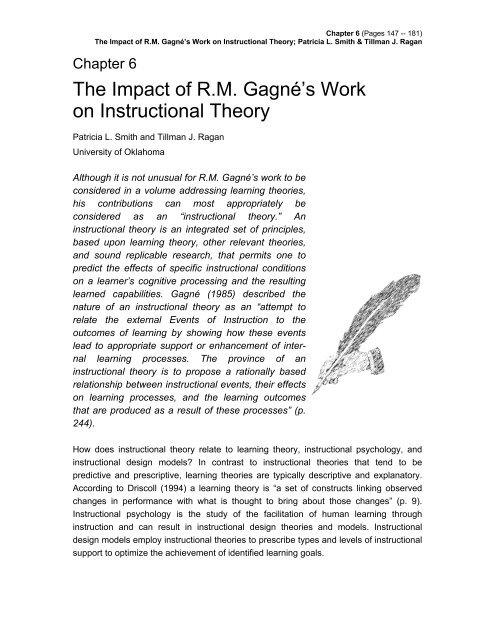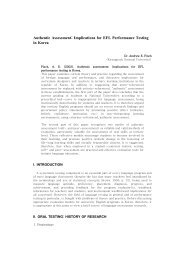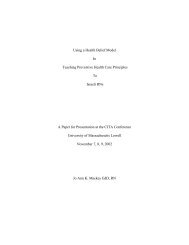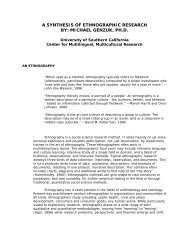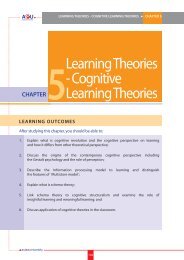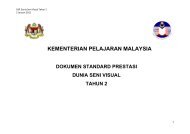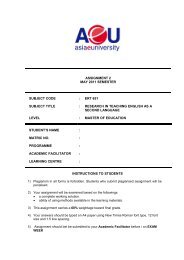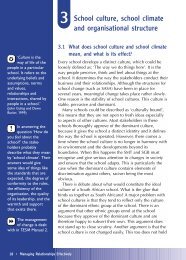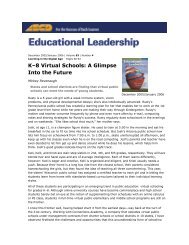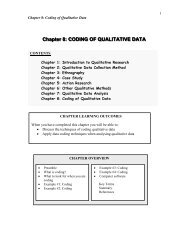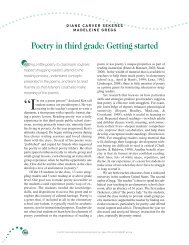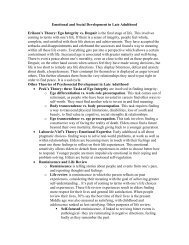Chapter 6 The Impact of R. M. Gagne's Work on Instructional Theory
Chapter 6 The Impact of R. M. Gagne's Work on Instructional Theory
Chapter 6 The Impact of R. M. Gagne's Work on Instructional Theory
- No tags were found...
Create successful ePaper yourself
Turn your PDF publications into a flip-book with our unique Google optimized e-Paper software.
<str<strong>on</strong>g>Chapter</str<strong>on</strong>g> 6 (Pages 147 -- 181)<br />
<str<strong>on</strong>g>The</str<strong>on</strong>g> <str<strong>on</strong>g>Impact</str<strong>on</strong>g> <str<strong>on</strong>g>of</str<strong>on</strong>g> R.M. Gagné’s <str<strong>on</strong>g>Work</str<strong>on</strong>g> <strong>on</strong> Instructi<strong>on</strong>al <str<strong>on</strong>g>The</str<strong>on</strong>g>ory; Patricia L. Smith & Tillman J. Ragan<br />
<str<strong>on</strong>g>Chapter</str<strong>on</strong>g> 6<br />
<str<strong>on</strong>g>The</str<strong>on</strong>g> <str<strong>on</strong>g>Impact</str<strong>on</strong>g> <str<strong>on</strong>g>of</str<strong>on</strong>g> R.M. Gagné’s <str<strong>on</strong>g>Work</str<strong>on</strong>g><br />
<strong>on</strong> Instructi<strong>on</strong>al <str<strong>on</strong>g>The</str<strong>on</strong>g>ory<br />
Patricia L. Smith and Tillman J. Ragan<br />
University <str<strong>on</strong>g>of</str<strong>on</strong>g> Oklahoma<br />
Although it is not unusual for R.M. Gagné’s work to be<br />
c<strong>on</strong>sidered in a volume addressing learning theories,<br />
his c<strong>on</strong>tributi<strong>on</strong>s can most appropriately be<br />
c<strong>on</strong>sidered as an “instructi<strong>on</strong>al theory.” An<br />
instructi<strong>on</strong>al theory is an integrated set <str<strong>on</strong>g>of</str<strong>on</strong>g> principles,<br />
based up<strong>on</strong> learning theory, other relevant theories,<br />
and sound replicable research, that permits <strong>on</strong>e to<br />
predict the effects <str<strong>on</strong>g>of</str<strong>on</strong>g> specific instructi<strong>on</strong>al c<strong>on</strong>diti<strong>on</strong>s<br />
<strong>on</strong> a learner’s cognitive processing and the resulting<br />
learned capabilities. Gagné (1985) described the<br />
nature <str<strong>on</strong>g>of</str<strong>on</strong>g> an instructi<strong>on</strong>al theory as an “attempt to<br />
relate the external Events <str<strong>on</strong>g>of</str<strong>on</strong>g> Instructi<strong>on</strong> to the<br />
outcomes <str<strong>on</strong>g>of</str<strong>on</strong>g> learning by showing how these events<br />
lead to appropriate support or enhancement <str<strong>on</strong>g>of</str<strong>on</strong>g> internal<br />
learning processes. <str<strong>on</strong>g>The</str<strong>on</strong>g> province <str<strong>on</strong>g>of</str<strong>on</strong>g> an<br />
instructi<strong>on</strong>al theory is to propose a rati<strong>on</strong>ally based<br />
relati<strong>on</strong>ship between instructi<strong>on</strong>al events, their effects<br />
<strong>on</strong> learning processes, and the learning outcomes<br />
that are produced as a result <str<strong>on</strong>g>of</str<strong>on</strong>g> these processes” (p.<br />
244).<br />
How does instructi<strong>on</strong>al theory relate to learning theory, instructi<strong>on</strong>al psychology, and<br />
instructi<strong>on</strong>al design models? In c<strong>on</strong>trast to instructi<strong>on</strong>al theories that tend to be<br />
predictive and prescriptive, learning theories are typically descriptive and explanatory.<br />
According to Driscoll (1994) a learning theory is “a set <str<strong>on</strong>g>of</str<strong>on</strong>g> c<strong>on</strong>structs linking observed<br />
changes in performance with what is thought to bring about those changes” (p. 9).<br />
Instructi<strong>on</strong>al psychology is the study <str<strong>on</strong>g>of</str<strong>on</strong>g> the facilitati<strong>on</strong> <str<strong>on</strong>g>of</str<strong>on</strong>g> human learning through<br />
instructi<strong>on</strong> and can result in instructi<strong>on</strong>al design theories and models. Instructi<strong>on</strong>al<br />
design models employ instructi<strong>on</strong>al theories to prescribe types and levels <str<strong>on</strong>g>of</str<strong>on</strong>g> instructi<strong>on</strong>al<br />
support to optimize the achievement <str<strong>on</strong>g>of</str<strong>on</strong>g> identified learning goals.
<str<strong>on</strong>g>Chapter</str<strong>on</strong>g> 6 (Pages 147 -- 181)<br />
<str<strong>on</strong>g>The</str<strong>on</strong>g> <str<strong>on</strong>g>Impact</str<strong>on</strong>g> <str<strong>on</strong>g>of</str<strong>on</strong>g> R.M. Gagné’s <str<strong>on</strong>g>Work</str<strong>on</strong>g> <strong>on</strong> Instructi<strong>on</strong>al <str<strong>on</strong>g>The</str<strong>on</strong>g>ory; Patricia L. Smith & Tillman J. Ragan<br />
Snow and Swans<strong>on</strong> (1992) suggested that the comp<strong>on</strong>ents <str<strong>on</strong>g>of</str<strong>on</strong>g> an instructi<strong>on</strong>al theory<br />
are: “(a) descripti<strong>on</strong> <str<strong>on</strong>g>of</str<strong>on</strong>g> desired end states or goals <str<strong>on</strong>g>of</str<strong>on</strong>g> instructi<strong>on</strong> in a domain; (b)<br />
descripti<strong>on</strong> <str<strong>on</strong>g>of</str<strong>on</strong>g> goal-relevant initial states <str<strong>on</strong>g>of</str<strong>on</strong>g> learners prior to instructi<strong>on</strong>; (c) explicati<strong>on</strong> <str<strong>on</strong>g>of</str<strong>on</strong>g><br />
the transiti<strong>on</strong> processes from initial to desired states; (d) specificati<strong>on</strong> <str<strong>on</strong>g>of</str<strong>on</strong>g> instructi<strong>on</strong>al<br />
c<strong>on</strong>diti<strong>on</strong>s that promote this transiti<strong>on</strong>; (e) assessment <str<strong>on</strong>g>of</str<strong>on</strong>g> performance and instructi<strong>on</strong>al<br />
effects” (p. 584). If we compare Gagné’s instructi<strong>on</strong>al theory to this descripti<strong>on</strong>, we find<br />
that Gagné’s theory does have these comp<strong>on</strong>ents. For example, Gagné describes<br />
potential end goal states in his categorizati<strong>on</strong> <str<strong>on</strong>g>of</str<strong>on</strong>g> learning capabilities. <str<strong>on</strong>g>The</str<strong>on</strong>g>se goal states<br />
are generic in that they can apply across a variety <str<strong>on</strong>g>of</str<strong>on</strong>g> c<strong>on</strong>tent areas. For each <str<strong>on</strong>g>of</str<strong>on</strong>g> the goal<br />
types Gagné described goal-relevant initial states, prerequisite relati<strong>on</strong>ship <str<strong>on</strong>g>of</str<strong>on</strong>g><br />
intellectual skills and relati<strong>on</strong>ships <str<strong>on</strong>g>of</str<strong>on</strong>g> other types <str<strong>on</strong>g>of</str<strong>on</strong>g> learning. Gagné interpreted<br />
informati<strong>on</strong> processing theory to explicate the transiti<strong>on</strong> processes from initial to goal<br />
states for each type <str<strong>on</strong>g>of</str<strong>on</strong>g> learning. Gagné’s greatest impact <strong>on</strong> instructi<strong>on</strong>al theory may be<br />
his thoroughness in specifying instructi<strong>on</strong>al c<strong>on</strong>diti<strong>on</strong>s to support this transiti<strong>on</strong> process.<br />
He described these instructi<strong>on</strong>al c<strong>on</strong>diti<strong>on</strong>s both as generalized events <str<strong>on</strong>g>of</str<strong>on</strong>g> instructi<strong>on</strong> and<br />
as specific c<strong>on</strong>diti<strong>on</strong>s <str<strong>on</strong>g>of</str<strong>on</strong>g> learning for each type <str<strong>on</strong>g>of</str<strong>on</strong>g> learning capability (C<strong>on</strong>diti<strong>on</strong>s <str<strong>on</strong>g>of</str<strong>on</strong>g><br />
Learning, 1965, 1970, 1977, 1985). Finally, Gagné and his colleagues extended his<br />
thorough explicati<strong>on</strong> <str<strong>on</strong>g>of</str<strong>on</strong>g> learning outcomes into recommendati<strong>on</strong>s for assessment within<br />
each category (Gagné & Beard, 1978; Gagné, Briggs, & Wager, 1992).<br />
Although Gagné was the first theorist to bring these elements together into an<br />
instructi<strong>on</strong>al theory, as with all learning/instructi<strong>on</strong>al theorists, his work was str<strong>on</strong>gly<br />
influenced by theorists who preceded him. C<strong>on</strong>sequently, to gain an adequate<br />
perspective <str<strong>on</strong>g>of</str<strong>on</strong>g> Gagné’s influence <strong>on</strong> instructi<strong>on</strong>al theory, we must first survey the status<br />
<str<strong>on</strong>g>of</str<strong>on</strong>g> instructi<strong>on</strong>al theory prior to Gagné’s influence.<br />
Status <str<strong>on</strong>g>of</str<strong>on</strong>g> Instructi<strong>on</strong>al <str<strong>on</strong>g>The</str<strong>on</strong>g>ory Before Gagné<br />
<str<strong>on</strong>g>The</str<strong>on</strong>g> need for instructi<strong>on</strong>al theory has l<strong>on</strong>g been recognized, and as early as 1899,<br />
William James pointed out that, as important as psychology is to educati<strong>on</strong>, it is not<br />
something from which the nature <str<strong>on</strong>g>of</str<strong>on</strong>g> the instructi<strong>on</strong> may be directly induced: “You make a<br />
great, a very great mistake, if you think that psychology, being a science <str<strong>on</strong>g>of</str<strong>on</strong>g> the mind’s<br />
laws, is something from which you can deduce definite programs and schemes and<br />
methods <str<strong>on</strong>g>of</str<strong>on</strong>g> instructi<strong>on</strong> for immediate schoolroom use” (James, 1899/1958, p. 23).<br />
Instructi<strong>on</strong>al theory remained an elusive topic before Gagné’s c<strong>on</strong>tributi<strong>on</strong>s <str<strong>on</strong>g>of</str<strong>on</strong>g> the early<br />
1960s. Two primary avenues <str<strong>on</strong>g>of</str<strong>on</strong>g> thought regarding instructi<strong>on</strong>al theory in the decade or<br />
so prior to Gagné’s major c<strong>on</strong>tributi<strong>on</strong>s were a focus <strong>on</strong>: (a) sequence and c<strong>on</strong>tent<br />
c<strong>on</strong>cerns from within a curriculum theory frame <str<strong>on</strong>g>of</str<strong>on</strong>g> reference; and (b) applicati<strong>on</strong> <str<strong>on</strong>g>of</str<strong>on</strong>g><br />
learning theory, particularly applicati<strong>on</strong>s within a programmed instructi<strong>on</strong> frame <str<strong>on</strong>g>of</str<strong>on</strong>g><br />
reference.
<str<strong>on</strong>g>Chapter</str<strong>on</strong>g> 6 (Pages 147 -- 181)<br />
<str<strong>on</strong>g>The</str<strong>on</strong>g> <str<strong>on</strong>g>Impact</str<strong>on</strong>g> <str<strong>on</strong>g>of</str<strong>on</strong>g> R.M. Gagné’s <str<strong>on</strong>g>Work</str<strong>on</strong>g> <strong>on</strong> Instructi<strong>on</strong>al <str<strong>on</strong>g>The</str<strong>on</strong>g>ory; Patricia L. Smith & Tillman J. Ragan<br />
Curriculum <str<strong>on</strong>g>The</str<strong>on</strong>g>ory<br />
Much work that characterizes the status <str<strong>on</strong>g>of</str<strong>on</strong>g> instructi<strong>on</strong>al theory before Gagné is seen in<br />
the work <str<strong>on</strong>g>of</str<strong>on</strong>g> curriculum theorists. People such as Bruner and Tyler are am<strong>on</strong>g those<br />
whose work c<strong>on</strong>centrated <strong>on</strong> matters <str<strong>on</strong>g>of</str<strong>on</strong>g> sequence and the c<strong>on</strong>tent <str<strong>on</strong>g>of</str<strong>on</strong>g> learning. Bruner’s<br />
(1960) c<strong>on</strong>cept <str<strong>on</strong>g>of</str<strong>on</strong>g> the spiral curriculum and Tyler’s c<strong>on</strong>cepti<strong>on</strong> <str<strong>on</strong>g>of</str<strong>on</strong>g> the “rati<strong>on</strong>ale” for a<br />
course as its design beginning point (1950) are examples <str<strong>on</strong>g>of</str<strong>on</strong>g> curriculum thinkers’<br />
c<strong>on</strong>tributi<strong>on</strong>s to instructi<strong>on</strong>al thinking.<br />
Historically, the persistent pattern in curriculum thinkers’ approaches to instructi<strong>on</strong> is to<br />
place primary emphasis up<strong>on</strong> teaching. Hosford (1973), for example, defined curriculum,<br />
instructi<strong>on</strong>, and teaching much as an instructi<strong>on</strong>al systems specialist or instructi<strong>on</strong>al<br />
technologist might, but he insisted <strong>on</strong> placing teaching at the center <str<strong>on</strong>g>of</str<strong>on</strong>g> his c<strong>on</strong>cepti<strong>on</strong> <str<strong>on</strong>g>of</str<strong>on</strong>g><br />
instructi<strong>on</strong> and, in subsequent treatment <str<strong>on</strong>g>of</str<strong>on</strong>g> a theory <str<strong>on</strong>g>of</str<strong>on</strong>g> instructi<strong>on</strong>, made the c<strong>on</strong>tinued<br />
assumpti<strong>on</strong> that teaching and teachers would be the primary (or <strong>on</strong>ly) means <str<strong>on</strong>g>of</str<strong>on</strong>g><br />
implementati<strong>on</strong>. Such a focus <strong>on</strong> teaching, it appears, prevented some curriculum<br />
theorists from thinking vigorously and directly about instructi<strong>on</strong> itself. N<strong>on</strong>etheless, for<br />
better or worse, the more philosophical c<strong>on</strong>tributi<strong>on</strong>s from curriculum thinkers formed a<br />
substantial proporti<strong>on</strong> <str<strong>on</strong>g>of</str<strong>on</strong>g> instructi<strong>on</strong>al theory.<br />
Bruner’s widely recognized work in instructi<strong>on</strong>al theory (1968) proposed four criteria that<br />
an instructi<strong>on</strong>al theory should meet. An adequate theory <str<strong>on</strong>g>of</str<strong>on</strong>g> instructi<strong>on</strong>, according to<br />
Bruner, would provide the basis for specificati<strong>on</strong> <str<strong>on</strong>g>of</str<strong>on</strong>g>: (a) experiences which will induce<br />
motivati<strong>on</strong> to learn, (b) optimal structures <str<strong>on</strong>g>of</str<strong>on</strong>g> knowledge for learning, (c) optimal<br />
sequences <str<strong>on</strong>g>of</str<strong>on</strong>g> encounter; and (d) the nature and pacing <str<strong>on</strong>g>of</str<strong>on</strong>g> rewards and punishments. In<br />
many regards Bruner’s widely heralded work seems now naive and quaint. His<br />
c<strong>on</strong>centrati<strong>on</strong> <strong>on</strong> structures <str<strong>on</strong>g>of</str<strong>on</strong>g> knowledge within disciplines reflects a teaching-centered<br />
view <str<strong>on</strong>g>of</str<strong>on</strong>g> instructi<strong>on</strong>. This structure <str<strong>on</strong>g>of</str<strong>on</strong>g> knowledge approach groups the “treatment <str<strong>on</strong>g>of</str<strong>on</strong>g> form<br />
<str<strong>on</strong>g>of</str<strong>on</strong>g> encounter” and “treatment <str<strong>on</strong>g>of</str<strong>on</strong>g> intrinsic motivati<strong>on</strong>” within a category labeled “rewards<br />
and punishments.”<br />
Before Gagné’s work had become widely recognized (and, <str<strong>on</strong>g>of</str<strong>on</strong>g> course, remaining<br />
c<strong>on</strong>venti<strong>on</strong>al in many educati<strong>on</strong> specialties today) many authorities believed that the<br />
most important instructi<strong>on</strong>al c<strong>on</strong>siderati<strong>on</strong>s lay within the structures <str<strong>on</strong>g>of</str<strong>on</strong>g> subject matter<br />
disciplines, and with the interface between those structures and the broad<br />
developmental characteristics <str<strong>on</strong>g>of</str<strong>on</strong>g> learners. <str<strong>on</strong>g>The</str<strong>on</strong>g> structures <str<strong>on</strong>g>of</str<strong>on</strong>g> knowledge within the<br />
various disciplines—such as science, mathematics, or history—were (and are) seen to<br />
vary radically from discipline to discipline in c<strong>on</strong>ceptual, syntactical, and substantive<br />
ways (Ford & Pugno, 1964; Phi Delta Kappa, 1964). Gagné brought scholarship to<br />
questi<strong>on</strong>s <str<strong>on</strong>g>of</str<strong>on</strong>g> learning from instructi<strong>on</strong> that arise from the psychological requirements <str<strong>on</strong>g>of</str<strong>on</strong>g>
<str<strong>on</strong>g>Chapter</str<strong>on</strong>g> 6 (Pages 147 -- 181)<br />
<str<strong>on</strong>g>The</str<strong>on</strong>g> <str<strong>on</strong>g>Impact</str<strong>on</strong>g> <str<strong>on</strong>g>of</str<strong>on</strong>g> R.M. Gagné’s <str<strong>on</strong>g>Work</str<strong>on</strong>g> <strong>on</strong> Instructi<strong>on</strong>al <str<strong>on</strong>g>The</str<strong>on</strong>g>ory; Patricia L. Smith & Tillman J. Ragan<br />
learning tasks, as opposed to questi<strong>on</strong>s which arise from parent disciplines from which<br />
subject matter comes. <str<strong>on</strong>g>The</str<strong>on</strong>g>refore, Gagné’s influence yielded prescriptive principles<br />
which—though not universally adopted in educati<strong>on</strong>al theory—have had a substantial<br />
impact up<strong>on</strong> the theory and research that examines educati<strong>on</strong>al practice.<br />
In a less widely recognized but at least equally valuable work that was c<strong>on</strong>temporary to<br />
Bruner’s, Gord<strong>on</strong> (1968) presented a relatively mature view <str<strong>on</strong>g>of</str<strong>on</strong>g> instructi<strong>on</strong> and<br />
instructi<strong>on</strong>al theory. Gord<strong>on</strong> defined a theory <str<strong>on</strong>g>of</str<strong>on</strong>g> instructi<strong>on</strong> as “a set <str<strong>on</strong>g>of</str<strong>on</strong>g> statements,<br />
based <strong>on</strong> replicable research, which would permit <strong>on</strong>e to predict how particular changes<br />
in the educati<strong>on</strong>al envir<strong>on</strong>ment (classroom setting) would affect pupil learning” (p. 3).<br />
Gord<strong>on</strong> differentiated the terms “instructi<strong>on</strong>” and “teaching” by noting that teaching<br />
“refers primarily to the human interacti<strong>on</strong> between teacher and pupil” (p. 3) and<br />
instructi<strong>on</strong> as the more encompassing term, referring to “the activity which takes place<br />
during instructi<strong>on</strong> and within the classroom setting. <str<strong>on</strong>g>The</str<strong>on</strong>g> term includes both material and<br />
human variables” (p. 3). <str<strong>on</strong>g>The</str<strong>on</strong>g> distincti<strong>on</strong>s that Gord<strong>on</strong> made between instructi<strong>on</strong> and<br />
teaching are useful <strong>on</strong>es, as the study <str<strong>on</strong>g>of</str<strong>on</strong>g> instructi<strong>on</strong> and the study <str<strong>on</strong>g>of</str<strong>on</strong>g> teaching are<br />
reflected as separate bodies <str<strong>on</strong>g>of</str<strong>on</strong>g> literature as well as distinct traditi<strong>on</strong>s <str<strong>on</strong>g>of</str<strong>on</strong>g> interest and<br />
inquiry. However, reflecting the curriculum and teaching methods orientati<strong>on</strong>, Gord<strong>on</strong><br />
restricted his c<strong>on</strong>cepti<strong>on</strong> <str<strong>on</strong>g>of</str<strong>on</strong>g> instructi<strong>on</strong> to classroom activities, a restricti<strong>on</strong> that might be<br />
viewed as limiting by current instructi<strong>on</strong>al theorists.<br />
Applied Learning <str<strong>on</strong>g>The</str<strong>on</strong>g>ory<br />
Although typically involving itself with animal c<strong>on</strong>diti<strong>on</strong>ing experiments, the mainstreams<br />
<str<strong>on</strong>g>of</str<strong>on</strong>g> learning psychology in the first half <str<strong>on</strong>g>of</str<strong>on</strong>g> the twentieth century, exemplified by Guthrie,<br />
Skinner, and Hull, were deeply c<strong>on</strong>cerned with human learning. Guthrie’s associati<strong>on</strong>centered<br />
theory (Guthrie, 1935, 1942) gave rise to Sheffield’s (1961) work in learning<br />
complex sequential tasks and Lumsdaine’s (1961) training research <strong>on</strong> effects <str<strong>on</strong>g>of</str<strong>on</strong>g> cueing.<br />
Skinner’s operant c<strong>on</strong>diti<strong>on</strong>ing saw applicati<strong>on</strong> by Skinner (1954) and Holland (1960).<br />
Hull’s detailed, systematic, and quantified approach to learning based <strong>on</strong> drive-reducti<strong>on</strong><br />
led to instructi<strong>on</strong>ally relevant research <strong>on</strong> feedback by Miller and Dollard (1941).<br />
Clearly, learning theory was in disarray when Hilgard wrote the c<strong>on</strong>cluding chapter to<br />
<str<strong>on</strong>g>The</str<strong>on</strong>g>ories <str<strong>on</strong>g>of</str<strong>on</strong>g> Learning (Hilgard, 1948): “We need a more careful delineati<strong>on</strong> <str<strong>on</strong>g>of</str<strong>on</strong>g> the kinds<br />
<str<strong>on</strong>g>of</str<strong>on</strong>g> learning which take place... This search for the appropriate c<strong>on</strong>cepts is not merely an<br />
exercise in definiti<strong>on</strong> or classificati<strong>on</strong>. It requires a high order <str<strong>on</strong>g>of</str<strong>on</strong>g> theory c<strong>on</strong>structi<strong>on</strong>,<br />
based <strong>on</strong> open-minded acceptance <str<strong>on</strong>g>of</str<strong>on</strong>g> dem<strong>on</strong>strable relati<strong>on</strong>ships” (p. 326–327). Almost<br />
30 years later, the c<strong>on</strong>cluding chapter in the fourth editi<strong>on</strong> <str<strong>on</strong>g>of</str<strong>on</strong>g> that work (Hilgard & Bower,<br />
1978) was entitled “Instructi<strong>on</strong>al <str<strong>on</strong>g>The</str<strong>on</strong>g>ory.” <str<strong>on</strong>g>The</str<strong>on</strong>g> first reference cited in that chapter is the<br />
first review <str<strong>on</strong>g>of</str<strong>on</strong>g> instructi<strong>on</strong>al psychology in Annual Reviews by Gagné and Rohwer (1969).<br />
Hilgard and Bower described Gagné’s work to that time as <strong>on</strong>e <str<strong>on</strong>g>of</str<strong>on</strong>g> three models that
<str<strong>on</strong>g>Chapter</str<strong>on</strong>g> 6 (Pages 147 -- 181)<br />
<str<strong>on</strong>g>The</str<strong>on</strong>g> <str<strong>on</strong>g>Impact</str<strong>on</strong>g> <str<strong>on</strong>g>of</str<strong>on</strong>g> R.M. Gagné’s <str<strong>on</strong>g>Work</str<strong>on</strong>g> <strong>on</strong> Instructi<strong>on</strong>al <str<strong>on</strong>g>The</str<strong>on</strong>g>ory; Patricia L. Smith & Tillman J. Ragan<br />
provide “indicati<strong>on</strong>s <str<strong>on</strong>g>of</str<strong>on</strong>g> what is to come” (1978, p. 614). In additi<strong>on</strong> to Gagné’s<br />
“hierarchical theory,” Bruner’s “cognitive-developmental theory” and Atkins<strong>on</strong>’s<br />
“decisi<strong>on</strong>-theoretic analysis for optimizing learning” are described. Of these, although all<br />
three did important subsequent work, Gagné appears to have g<strong>on</strong>e the furthest toward<br />
development <str<strong>on</strong>g>of</str<strong>on</strong>g> a full instructi<strong>on</strong>al theory.<br />
A great deal <str<strong>on</strong>g>of</str<strong>on</strong>g> interest in the 1950’s was generated by the innovati<strong>on</strong> called<br />
“programmed instructi<strong>on</strong>.” Embodied in both teaching-machine and text-based forms,<br />
programmed instructi<strong>on</strong> carried with it ideas <str<strong>on</strong>g>of</str<strong>on</strong>g> far greater importance than the<br />
competing specific forms and rules dictating format that were matters <str<strong>on</strong>g>of</str<strong>on</strong>g> heated debate<br />
at the time. With programmed instructi<strong>on</strong>, an agency other than a pers<strong>on</strong> was seen as<br />
an instrument <str<strong>on</strong>g>of</str<strong>on</strong>g> instructi<strong>on</strong>. Previously, all n<strong>on</strong>-human tools including books, televisi<strong>on</strong>,<br />
and the various forms <str<strong>on</strong>g>of</str<strong>on</strong>g> audiovisual media, were c<strong>on</strong>ceptualized as aids or resources<br />
for a teacher’s use. Even the powerful medium <str<strong>on</strong>g>of</str<strong>on</strong>g> moti<strong>on</strong> pictures (and later televisi<strong>on</strong>)<br />
was viewed as something that had “classroom” uses, which required a teacher’s<br />
introducti<strong>on</strong> and follow-up for meaningful learning to anticipated.<br />
This radical change in view <str<strong>on</strong>g>of</str<strong>on</strong>g> the potential <str<strong>on</strong>g>of</str<strong>on</strong>g> instructi<strong>on</strong>al media brought with it a radical<br />
change in what might be studied as “instructi<strong>on</strong>” and how research <strong>on</strong> it might be<br />
c<strong>on</strong>ducted. In his landmark review, “Instruments and Media <str<strong>on</strong>g>of</str<strong>on</strong>g> Instructi<strong>on</strong>,” Lumsdaine<br />
(1963) pointed out the significance <str<strong>on</strong>g>of</str<strong>on</strong>g> the ideas behind programmed instructi<strong>on</strong> for<br />
thinking about research <strong>on</strong> instructi<strong>on</strong>: “...the c<strong>on</strong>trol <str<strong>on</strong>g>of</str<strong>on</strong>g> learner behavior and feedback<br />
which is provided by the c<strong>on</strong>tinuous record <str<strong>on</strong>g>of</str<strong>on</strong>g> student resp<strong>on</strong>se from auto-instructi<strong>on</strong>al<br />
programs may afford the most promising vehicle yet developed for the analytic<br />
experimental study <str<strong>on</strong>g>of</str<strong>on</strong>g> variables affecting human learning (as well as for the incorporati<strong>on</strong><br />
<str<strong>on</strong>g>of</str<strong>on</strong>g> research findings in improved instruments)” (Lumsdaine, 1963, p. 608). Research <strong>on</strong><br />
programmed instructi<strong>on</strong> brought with it, perhaps unknowingly but certainly inevitably,<br />
focused c<strong>on</strong>cern <strong>on</strong> matters <str<strong>on</strong>g>of</str<strong>on</strong>g> form <str<strong>on</strong>g>of</str<strong>on</strong>g> encounter with material to be learned outside the<br />
frame <str<strong>on</strong>g>of</str<strong>on</strong>g> reference <str<strong>on</strong>g>of</str<strong>on</strong>g> “teaching.” As teaching itself is not a reproducible event, the study<br />
<str<strong>on</strong>g>of</str<strong>on</strong>g> teaching has focused <strong>on</strong> matters that can be <str<strong>on</strong>g>of</str<strong>on</strong>g> ultimate utility in understanding the<br />
role <str<strong>on</strong>g>of</str<strong>on</strong>g> teachers, understanding the teaching act, and understanding interacti<strong>on</strong>s am<strong>on</strong>g<br />
teachers, learners, and activities. When studying instructi<strong>on</strong>-using agencies providing<br />
sequenced and reproducible events, c<strong>on</strong>trolled investigati<strong>on</strong>s <str<strong>on</strong>g>of</str<strong>on</strong>g> form <str<strong>on</strong>g>of</str<strong>on</strong>g> encounter<br />
became practicable. An enormous corpus <str<strong>on</strong>g>of</str<strong>on</strong>g> research was developed during the 1950s<br />
and 1960s under the programmed instructi<strong>on</strong> umbrella in areas such as practice,<br />
feedback, sequence, and criteri<strong>on</strong>-referenced assessment.<br />
One example <str<strong>on</strong>g>of</str<strong>on</strong>g> how work in programmed instructi<strong>on</strong> c<strong>on</strong>tributed to instructi<strong>on</strong>al theory<br />
can be seen in “validati<strong>on</strong>” procedures for programmed instructi<strong>on</strong>. <str<strong>on</strong>g>The</str<strong>on</strong>g> first work in what<br />
would now be labeled “formative evaluati<strong>on</strong>” was developed under the noti<strong>on</strong> <str<strong>on</strong>g>of</str<strong>on</strong>g> “how
<str<strong>on</strong>g>Chapter</str<strong>on</strong>g> 6 (Pages 147 -- 181)<br />
<str<strong>on</strong>g>The</str<strong>on</strong>g> <str<strong>on</strong>g>Impact</str<strong>on</strong>g> <str<strong>on</strong>g>of</str<strong>on</strong>g> R.M. Gagné’s <str<strong>on</strong>g>Work</str<strong>on</strong>g> <strong>on</strong> Instructi<strong>on</strong>al <str<strong>on</strong>g>The</str<strong>on</strong>g>ory; Patricia L. Smith & Tillman J. Ragan<br />
should programmed instructi<strong>on</strong> be validated?” Procedures for the development and<br />
establishment <str<strong>on</strong>g>of</str<strong>on</strong>g> known quality in programmed instructi<strong>on</strong> materials have evolved over<br />
the years to include instructi<strong>on</strong> in any form and are the basis <str<strong>on</strong>g>of</str<strong>on</strong>g> current formative<br />
evaluati<strong>on</strong> principles and procedures. Other examples can be seen in studies <strong>on</strong> such<br />
areas as instructi<strong>on</strong>al feedback, instructi<strong>on</strong>al event sequencing, pacing, optimal<br />
prompting <str<strong>on</strong>g>of</str<strong>on</strong>g> practice, and forms <str<strong>on</strong>g>of</str<strong>on</strong>g> practice and resp<strong>on</strong>se.<br />
Other cornerst<strong>on</strong>es <str<strong>on</strong>g>of</str<strong>on</strong>g> c<strong>on</strong>temporary instructi<strong>on</strong>al design have their roots in programmed<br />
instructi<strong>on</strong>. However, the generalizati<strong>on</strong>s which transpired from noti<strong>on</strong>s <str<strong>on</strong>g>of</str<strong>on</strong>g> “how to best<br />
implement a particular programmed instructi<strong>on</strong> format” <strong>on</strong> the <strong>on</strong>e hand into “how to<br />
optimally c<strong>on</strong>duct instructi<strong>on</strong>” <strong>on</strong> the other, are not trivial. Gradually attenti<strong>on</strong> began to<br />
shift from the procedural details to variables, questi<strong>on</strong>s, and models <str<strong>on</strong>g>of</str<strong>on</strong>g> instructi<strong>on</strong> that<br />
would underlie the techniques. No <strong>on</strong>e c<strong>on</strong>tributed more to this shift in thinking—much <str<strong>on</strong>g>of</str<strong>on</strong>g><br />
his own work in the 1950s and early 1960s can be seen as an embodiment <str<strong>on</strong>g>of</str<strong>on</strong>g> it—than<br />
Robert Gagné.<br />
Precursors to Instructi<strong>on</strong>al <str<strong>on</strong>g>The</str<strong>on</strong>g>ory<br />
Of the schools <str<strong>on</strong>g>of</str<strong>on</strong>g> thought that underlie instructi<strong>on</strong>al theory, Gagné clearly comes from<br />
the “applied science” perspective. As a psychologist, he studied learning in demanding,<br />
realistic settings, and was, in fact, somewhat impatient with colleagues whose purity <str<strong>on</strong>g>of</str<strong>on</strong>g><br />
purpose prevented their doing the messier and <str<strong>on</strong>g>of</str<strong>on</strong>g>ten less clear applied research that<br />
instructi<strong>on</strong>al theory building requires. In a review <str<strong>on</strong>g>of</str<strong>on</strong>g> factors that c<strong>on</strong>tribute to learning<br />
efficiency for a volume <strong>on</strong> programmed instructi<strong>on</strong> sp<strong>on</strong>sored by the Air Force Office <str<strong>on</strong>g>of</str<strong>on</strong>g><br />
Scientific Research, Gagné and Bolles noted that “the learning tasks that have been<br />
most intensively studied by psychologists have been <str<strong>on</strong>g>of</str<strong>on</strong>g> an artificial “laboratory” variety;<br />
relatively little is known about learning in real life situati<strong>on</strong>s” (Gagné & Bolles, 1959, pp.<br />
13–14).<br />
Training research in the 1950s put Gagné in touch with a wide range <str<strong>on</strong>g>of</str<strong>on</strong>g> instructi<strong>on</strong>al<br />
problems, representing a variety <str<strong>on</strong>g>of</str<strong>on</strong>g> learning tasks. Illustrative studies in the literature are<br />
Gagné (1954) “An Analysis <str<strong>on</strong>g>of</str<strong>on</strong>g> Two Problem Solving Activities” involving troubleshooting<br />
and interpretati<strong>on</strong> <str<strong>on</strong>g>of</str<strong>on</strong>g> aerial photographs, and Gagné, Baker, & Wylie (1951) “Effects <str<strong>on</strong>g>of</str<strong>on</strong>g><br />
an Interfering Task <strong>on</strong> the Learning <str<strong>on</strong>g>of</str<strong>on</strong>g> a Complex Motor Skill” involving manipulati<strong>on</strong>s <str<strong>on</strong>g>of</str<strong>on</strong>g><br />
c<strong>on</strong>trols similar to aircraft c<strong>on</strong>trols. In a review <str<strong>on</strong>g>of</str<strong>on</strong>g> problem-solving and thinking, Gagné<br />
pointed out the relevance <str<strong>on</strong>g>of</str<strong>on</strong>g> trouble shooting studies to issues in c<strong>on</strong>cept formati<strong>on</strong><br />
(Gagné, 1959). Wide and vigorous participati<strong>on</strong> in research <strong>on</strong> learning and instructi<strong>on</strong> in<br />
the military envir<strong>on</strong>ment, al<strong>on</strong>g with his thorough and rigorous background as a learning<br />
psychologist, may have created the diss<strong>on</strong>ance that motivated Gagné to develop the<br />
c<strong>on</strong>cepts <str<strong>on</strong>g>of</str<strong>on</strong>g> types <str<strong>on</strong>g>of</str<strong>on</strong>g> learning, learning hierarchies, internal c<strong>on</strong>diti<strong>on</strong>s <str<strong>on</strong>g>of</str<strong>on</strong>g> learning, and
<str<strong>on</strong>g>Chapter</str<strong>on</strong>g> 6 (Pages 147 -- 181)<br />
<str<strong>on</strong>g>The</str<strong>on</strong>g> <str<strong>on</strong>g>Impact</str<strong>on</strong>g> <str<strong>on</strong>g>of</str<strong>on</strong>g> R.M. Gagné’s <str<strong>on</strong>g>Work</str<strong>on</strong>g> <strong>on</strong> Instructi<strong>on</strong>al <str<strong>on</strong>g>The</str<strong>on</strong>g>ory; Patricia L. Smith & Tillman J. Ragan<br />
events <str<strong>on</strong>g>of</str<strong>on</strong>g> instructi<strong>on</strong>, including external c<strong>on</strong>diti<strong>on</strong>s <str<strong>on</strong>g>of</str<strong>on</strong>g> learning. In the following pages, we<br />
will discuss each <str<strong>on</strong>g>of</str<strong>on</strong>g> these three c<strong>on</strong>tributi<strong>on</strong>s to instructi<strong>on</strong>al theory.<br />
Instructi<strong>on</strong>al <str<strong>on</strong>g>The</str<strong>on</strong>g>ory C<strong>on</strong>tributi<strong>on</strong>s<br />
Gagné developed four major propositi<strong>on</strong>s that c<strong>on</strong>stitute his instructi<strong>on</strong>al theory:<br />
(a) Learning goals can be categorized as to learning outcome or knowledge type<br />
(types <str<strong>on</strong>g>of</str<strong>on</strong>g> learning);<br />
(b) Learning outcomes can be represented in a predictable pre requisite<br />
relati<strong>on</strong>ship (learning hierarchies);<br />
(c) Acquisiti<strong>on</strong> <str<strong>on</strong>g>of</str<strong>on</strong>g> different outcome categories requires different internal<br />
processes (internal c<strong>on</strong>diti<strong>on</strong>s <str<strong>on</strong>g>of</str<strong>on</strong>g> learning);<br />
(d) Acquisiti<strong>on</strong> <str<strong>on</strong>g>of</str<strong>on</strong>g> different outcome categories requires identifiably different<br />
instructi<strong>on</strong>al processes (events <str<strong>on</strong>g>of</str<strong>on</strong>g> instructi<strong>on</strong> and external c<strong>on</strong>diti<strong>on</strong>s <str<strong>on</strong>g>of</str<strong>on</strong>g><br />
learning).<br />
Development <str<strong>on</strong>g>of</str<strong>on</strong>g> Types <str<strong>on</strong>g>of</str<strong>on</strong>g> Learning<br />
Gagné was, <str<strong>on</strong>g>of</str<strong>on</strong>g> course, not the first theorist to suggest that all learning is not alike, that<br />
learning might be analyzed into different types <str<strong>on</strong>g>of</str<strong>on</strong>g> learning. Indeed, as early as 1933 Carr<br />
suggested classes <str<strong>on</strong>g>of</str<strong>on</strong>g> experimental learning tasks and warned that principles that had<br />
been derived about <strong>on</strong>e set <str<strong>on</strong>g>of</str<strong>on</strong>g> tasks could not necessarily be generalized to other<br />
classes (Melt<strong>on</strong>, 1964). In the 1940s scientists such as Melt<strong>on</strong> (1941) and Tolman<br />
(1949) c<strong>on</strong>tinued the efforts to categorize learning types. During an informal meeting <str<strong>on</strong>g>of</str<strong>on</strong>g><br />
college examiners at the 1948 American Psychological Associati<strong>on</strong> c<strong>on</strong>ference, Bloom<br />
and his colleagues discussed the need for a set <str<strong>on</strong>g>of</str<strong>on</strong>g> comm<strong>on</strong> descriptors <str<strong>on</strong>g>of</str<strong>on</strong>g> learning to<br />
facilitate communicati<strong>on</strong> am<strong>on</strong>g them. This effort resulted in “Bloom’s Tax<strong>on</strong>omy” <str<strong>on</strong>g>of</str<strong>on</strong>g><br />
cognitive educati<strong>on</strong>al objectives (Bloom, Englehart, Furst, Hill, & Krathwohl, 1956) and<br />
Krathwohl’s tax<strong>on</strong>omy <str<strong>on</strong>g>of</str<strong>on</strong>g> affective educati<strong>on</strong>al objectives (Krathwohl, Bloom, & Masia,<br />
1964). Despite the original intenti<strong>on</strong> <str<strong>on</strong>g>of</str<strong>on</strong>g> these tax<strong>on</strong>omies to standardize terminology,<br />
they readily assumed the stature <str<strong>on</strong>g>of</str<strong>on</strong>g> psychologically-based correlates.<br />
In 1962, Melt<strong>on</strong> organized a “Symposium <strong>on</strong> the Psychology <str<strong>on</strong>g>of</str<strong>on</strong>g> Human Learning” that<br />
was held at the University <str<strong>on</strong>g>of</str<strong>on</strong>g> Michigan in Ann Arbor. <str<strong>on</strong>g>The</str<strong>on</strong>g> focus <str<strong>on</strong>g>of</str<strong>on</strong>g> the symposium was to<br />
discuss “the interrelati<strong>on</strong>ship <str<strong>on</strong>g>of</str<strong>on</strong>g> different categories <str<strong>on</strong>g>of</str<strong>on</strong>g> human learning” (p. vii). Melt<strong>on</strong><br />
later edited a book Categories <str<strong>on</strong>g>of</str<strong>on</strong>g> Human Learning (1964) that compiled many <str<strong>on</strong>g>of</str<strong>on</strong>g> the<br />
papers from this symposium. Am<strong>on</strong>g these was Robert Gagné’s chapter “Problem<br />
Solving.” In this chapter Gagné presented a table entitled “A Suggested Ordering <str<strong>on</strong>g>of</str<strong>on</strong>g> the<br />
Types <str<strong>on</strong>g>of</str<strong>on</strong>g> Human Learning” in which he proposed the following six types <str<strong>on</strong>g>of</str<strong>on</strong>g> learning:<br />
Resp<strong>on</strong>se learning, chaining, verbal learning (paired-associates), c<strong>on</strong>cept learning,
<str<strong>on</strong>g>Chapter</str<strong>on</strong>g> 6 (Pages 147 -- 181)<br />
<str<strong>on</strong>g>The</str<strong>on</strong>g> <str<strong>on</strong>g>Impact</str<strong>on</strong>g> <str<strong>on</strong>g>of</str<strong>on</strong>g> R.M. Gagné’s <str<strong>on</strong>g>Work</str<strong>on</strong>g> <strong>on</strong> Instructi<strong>on</strong>al <str<strong>on</strong>g>The</str<strong>on</strong>g>ory; Patricia L. Smith & Tillman J. Ragan<br />
principle learning, problem solving (Gagné, 1964). Gagné did not cite a previous<br />
publicati<strong>on</strong> related to these c<strong>on</strong>cepts, so this chapter may be the first appearance <str<strong>on</strong>g>of</str<strong>on</strong>g> his<br />
“types <str<strong>on</strong>g>of</str<strong>on</strong>g> learning outcomes” categories. In this chapter he began to differentiate<br />
between verbal learning and “n<strong>on</strong>reproductive” types <str<strong>on</strong>g>of</str<strong>on</strong>g> learning, such as c<strong>on</strong>cept<br />
learning and problem solving. This differentiati<strong>on</strong> eventually led to his separate domains<br />
<str<strong>on</strong>g>of</str<strong>on</strong>g> learning <str<strong>on</strong>g>of</str<strong>on</strong>g> “verbal learning” and “intellectual skills.”<br />
Gagné presented the first complete statement <str<strong>on</strong>g>of</str<strong>on</strong>g> the types <str<strong>on</strong>g>of</str<strong>on</strong>g> learning c<strong>on</strong>cepti<strong>on</strong> in his<br />
first editi<strong>on</strong> <str<strong>on</strong>g>of</str<strong>on</strong>g> <str<strong>on</strong>g>The</str<strong>on</strong>g> C<strong>on</strong>diti<strong>on</strong>s <str<strong>on</strong>g>of</str<strong>on</strong>g> Learning (Gagné, 1965). He began by reviewing<br />
learning theory and research, such as James, Dewey, Wats<strong>on</strong>, Thorndike, Tolman,<br />
Ebbinghaus, Pavlov, and Köhler, introducing the idea <str<strong>on</strong>g>of</str<strong>on</strong>g> types <str<strong>on</strong>g>of</str<strong>on</strong>g> learning with the noti<strong>on</strong><br />
<str<strong>on</strong>g>of</str<strong>on</strong>g> “learning prototypes:”<br />
Throughout the period <str<strong>on</strong>g>of</str<strong>on</strong>g> scientific investigati<strong>on</strong> <str<strong>on</strong>g>of</str<strong>on</strong>g> learning there has been<br />
frequent recourse to certain typical experimental situati<strong>on</strong>s to serve as prototypes<br />
for learning. . . . <str<strong>on</strong>g>The</str<strong>on</strong>g>se learning prototypes all have a similar history in this<br />
respect: each <str<strong>on</strong>g>of</str<strong>on</strong>g> them started to be a representative <str<strong>on</strong>g>of</str<strong>on</strong>g> a particular variety <str<strong>on</strong>g>of</str<strong>on</strong>g><br />
learning situati<strong>on</strong>s. Thorndike wanted to study animal associati<strong>on</strong>. Pavlov was<br />
studying reflexes. Ebbinghaus studied the memorizati<strong>on</strong> <str<strong>on</strong>g>of</str<strong>on</strong>g> verbal lists. Köhler<br />
was studying the solving <str<strong>on</strong>g>of</str<strong>on</strong>g> problems by animals. By some peculiar semantic<br />
process, these examples became prototypes <str<strong>on</strong>g>of</str<strong>on</strong>g> learning, and thus were<br />
c<strong>on</strong>sidered to represent the domain <str<strong>on</strong>g>of</str<strong>on</strong>g> learning as a whole, or at least in large<br />
part (p. 18–19).<br />
Gagné (1965) presented eight types <str<strong>on</strong>g>of</str<strong>on</strong>g> learning in the first editi<strong>on</strong>, in a rather strict<br />
hierarchical relati<strong>on</strong>ship. He described all types but the first, signal learning (classical<br />
c<strong>on</strong>diti<strong>on</strong>ing), as having prerequisite relati<strong>on</strong>ships with <strong>on</strong>e another. Gagné carefully<br />
referenced researchers that had examined these eight types <str<strong>on</strong>g>of</str<strong>on</strong>g> learning:<br />
1. Signal Learning (Pavlov, 1927)<br />
2. Stimulus-Resp<strong>on</strong>se Learning (Thorndike, 1898; Skinner, 1938; Kimble, 1961)<br />
3. Chaining (Skinner, 1938; Gilbert, 1962)<br />
4. Verbal Associati<strong>on</strong> (Underwood, 1964)<br />
5. Multiple Discriminati<strong>on</strong> (Postman, 1961)<br />
6. C<strong>on</strong>cept Learning (Kendler, 1964)<br />
7. Principle Learning (Gagné, 1964)<br />
8. Problem Solving (Kat<strong>on</strong>a, 1940; Maier, 1930) (pp. 58–59).<br />
This list remained relatively unchanged in the sec<strong>on</strong>d editi<strong>on</strong> <str<strong>on</strong>g>of</str<strong>on</strong>g> C<strong>on</strong>diti<strong>on</strong>s <str<strong>on</strong>g>of</str<strong>on</strong>g> Learning<br />
(1970). By the third editi<strong>on</strong> (Gagné, 1977), Gagné added informati<strong>on</strong> processing theories
<str<strong>on</strong>g>Chapter</str<strong>on</strong>g> 6 (Pages 147 -- 181)<br />
<str<strong>on</strong>g>The</str<strong>on</strong>g> <str<strong>on</strong>g>Impact</str<strong>on</strong>g> <str<strong>on</strong>g>of</str<strong>on</strong>g> R.M. Gagné’s <str<strong>on</strong>g>Work</str<strong>on</strong>g> <strong>on</strong> Instructi<strong>on</strong>al <str<strong>on</strong>g>The</str<strong>on</strong>g>ory; Patricia L. Smith & Tillman J. Ragan<br />
to the treatment <str<strong>on</strong>g>of</str<strong>on</strong>g> learning prototypes, recasting the types <str<strong>on</strong>g>of</str<strong>on</strong>g> learning to some degree<br />
by their different cognitive demands. In additi<strong>on</strong>, an increasing influence <str<strong>on</strong>g>of</str<strong>on</strong>g> task<br />
characteristics, rather than psychological processes guided the form and c<strong>on</strong>tent <str<strong>on</strong>g>of</str<strong>on</strong>g> the<br />
types <str<strong>on</strong>g>of</str<strong>on</strong>g> learning. In its latest form as <str<strong>on</strong>g>of</str<strong>on</strong>g> this writing (Fourth Editi<strong>on</strong>, Gagné, 1985), he<br />
identified distinctly different categories within the domain <str<strong>on</strong>g>of</str<strong>on</strong>g> intellectual skills:<br />
discriminati<strong>on</strong>s, c<strong>on</strong>cepts, rules, and higher-order rules (domain-specific problem<br />
solving). He proposed that these knowledge types are in a prerequisite, vertical transfer<br />
relati<strong>on</strong>ship, with discriminati<strong>on</strong>s pre requisite to c<strong>on</strong>cepts, c<strong>on</strong>cepts prerequisite to<br />
rules, and rules prerequisite to problem solving. <str<strong>on</strong>g>The</str<strong>on</strong>g> types <str<strong>on</strong>g>of</str<strong>on</strong>g> learning in the fourth<br />
editi<strong>on</strong> are:<br />
1. Intellectual Skills<br />
• discriminati<strong>on</strong>s<br />
• c<strong>on</strong>cepts<br />
• rules<br />
• problem solving<br />
2. Cognitive Strategies<br />
3. Verbal Informati<strong>on</strong><br />
4. Motor Skills<br />
5. Attitudes<br />
(In 1984 Gagné pointed out that the verbal informati<strong>on</strong> category could also be termed<br />
“declarative knowledge” and the intellectual skills category could be termed “procedural<br />
knowledge.”)<br />
More recently, Gagné and Merrill (1990) identified another category, which they termed<br />
“enterprise” (see <str<strong>on</strong>g>Chapter</str<strong>on</strong>g> 5). <str<strong>on</strong>g>The</str<strong>on</strong>g>y described this category as being substantively<br />
different from the other learning outcomes that Gagné or Merrill had previously identified,<br />
requiring the integrati<strong>on</strong> <str<strong>on</strong>g>of</str<strong>on</strong>g> the other more simple learning outcomes, such as rules,<br />
c<strong>on</strong>cepts, and declarative knowledge.<br />
<str<strong>on</strong>g>The</str<strong>on</strong>g>re are two ways in which <strong>on</strong>e might view these outcomes: as descripti<strong>on</strong>s <str<strong>on</strong>g>of</str<strong>on</strong>g> tasks<br />
(with external “task-related” differences) or as descripti<strong>on</strong>s <str<strong>on</strong>g>of</str<strong>on</strong>g> learned abilities (with<br />
differences arising out <str<strong>on</strong>g>of</str<strong>on</strong>g> distinctive processing or memory structures). Gagné has<br />
tended to define these outcomes as the latter, describing them as “learned dispositi<strong>on</strong>s,”<br />
“capabilities,” or “l<strong>on</strong>g term memory states,” (1985, p. 245). He described verbal<br />
informati<strong>on</strong> and intellectual skills as having distinctly different memory storage systems,<br />
c<strong>on</strong>sistent with those <str<strong>on</strong>g>of</str<strong>on</strong>g> other theorists, such as Anders<strong>on</strong> (1990). An empirical basis for<br />
the “verbal informati<strong>on</strong>” knowledge to be stored as propositi<strong>on</strong>al networks is provided by<br />
Gagné and White (1978). Rule-using is described by Gagné and White as stored in<br />
hierarchical skill structures, which they referred to as “intellectual skills.” Verbal
<str<strong>on</strong>g>Chapter</str<strong>on</strong>g> 6 (Pages 147 -- 181)<br />
<str<strong>on</strong>g>The</str<strong>on</strong>g> <str<strong>on</strong>g>Impact</str<strong>on</strong>g> <str<strong>on</strong>g>of</str<strong>on</strong>g> R.M. Gagné’s <str<strong>on</strong>g>Work</str<strong>on</strong>g> <strong>on</strong> Instructi<strong>on</strong>al <str<strong>on</strong>g>The</str<strong>on</strong>g>ory; Patricia L. Smith & Tillman J. Ragan<br />
informati<strong>on</strong> has been described more recently by Gagné (1985) as being stored as<br />
propositi<strong>on</strong>al networks or schemata. He described rules, including c<strong>on</strong>cepts (defining<br />
rules), as being stored as “if ... then” producti<strong>on</strong>s. <str<strong>on</strong>g>The</str<strong>on</strong>g> storage <str<strong>on</strong>g>of</str<strong>on</strong>g> problem solving<br />
capabilities themselves was not addressed, although interc<strong>on</strong>necti<strong>on</strong>s <str<strong>on</strong>g>of</str<strong>on</strong>g> schemata and<br />
producti<strong>on</strong>s were implied. <str<strong>on</strong>g>The</str<strong>on</strong>g> storage mechanisms <str<strong>on</strong>g>of</str<strong>on</strong>g> attitudes, motor skills, or cognitive<br />
strategies are also not explicitly discussed.<br />
Gagné’s categorizati<strong>on</strong> <str<strong>on</strong>g>of</str<strong>on</strong>g> learning outcomes has not been without its critics. Gagné<br />
characterized his categorizati<strong>on</strong> system as more internally than externally derived.<br />
Kyll<strong>on</strong>en and Schute (1989) criticized this characteristic, describing Gagné’s<br />
categorizati<strong>on</strong> <str<strong>on</strong>g>of</str<strong>on</strong>g> learning types as a “rati<strong>on</strong>al tax<strong>on</strong>omy,” developed via proposing “task<br />
categories in terms <str<strong>on</strong>g>of</str<strong>on</strong>g> characteristics that will foster or inhibit learned performance” (p.<br />
120). <str<strong>on</strong>g>The</str<strong>on</strong>g>y suggested that the limitati<strong>on</strong> <str<strong>on</strong>g>of</str<strong>on</strong>g> such categories is that their basis is not<br />
psychological processes and, therefore, such processes are unsystematically<br />
c<strong>on</strong>sidered.<br />
Development <str<strong>on</strong>g>of</str<strong>on</strong>g> the Learning Hierarchies C<strong>on</strong>cept<br />
Perhaps as significant as his delineati<strong>on</strong> <str<strong>on</strong>g>of</str<strong>on</strong>g> categories <str<strong>on</strong>g>of</str<strong>on</strong>g> learning, is Gagné’s c<strong>on</strong>cepti<strong>on</strong><br />
<str<strong>on</strong>g>of</str<strong>on</strong>g> a learning hierarchy (see <str<strong>on</strong>g>Chapter</str<strong>on</strong>g> 2). Although this hierarchical relati<strong>on</strong>ship was<br />
implied in the tax<strong>on</strong>omies <str<strong>on</strong>g>of</str<strong>on</strong>g> a number <str<strong>on</strong>g>of</str<strong>on</strong>g> theorists (Cotterman, 1959; Demaree, 1961;<br />
Lumsdaine, 1960; Miller, 1962; Parker & Downs, 1961; Stolurow, 1964; Willis &<br />
Peters<strong>on</strong>, 1961), it was Gagné who brought the c<strong>on</strong>cepti<strong>on</strong> <str<strong>on</strong>g>of</str<strong>on</strong>g> “learning hierarchy” clearly<br />
into focus with his statements regarding the nature <str<strong>on</strong>g>of</str<strong>on</strong>g> these relati<strong>on</strong>ships and his<br />
research to validate these principles.<br />
Gagné’s first references to “learning hierarchies” appears in articles published in 1962, a<br />
report <str<strong>on</strong>g>of</str<strong>on</strong>g> a study, “Factors in Acquiring Knowledge <str<strong>on</strong>g>of</str<strong>on</strong>g> a Mathematical Task” (Gagné,<br />
Mayor, Garstens, & Paradise, 1962) and another study, “<str<strong>on</strong>g>The</str<strong>on</strong>g> Acquisiti<strong>on</strong> <str<strong>on</strong>g>of</str<strong>on</strong>g> Knowledge,”<br />
(Gagné, 1962) which involved similar learning tasks. <str<strong>on</strong>g>The</str<strong>on</strong>g>se reports were preceded by<br />
Gagné and Paradise’s 1961 study, which formed a foundati<strong>on</strong> for the latter studies. In<br />
1961, Gagné and Paradise found support for the propositi<strong>on</strong> that transfer <str<strong>on</strong>g>of</str<strong>on</strong>g> learning<br />
from subordinate sets <str<strong>on</strong>g>of</str<strong>on</strong>g> learning tasks could account for performance in a terminal<br />
learning task. In a subsequent study, Gagné, Mayor, Garstens, and Paradise (1962)<br />
sought to extend and c<strong>on</strong>firm the validity <str<strong>on</strong>g>of</str<strong>on</strong>g> the idea <str<strong>on</strong>g>of</str<strong>on</strong>g> the “learning hierarchy.” In this<br />
study, the posttest supplied informati<strong>on</strong> about achievement <str<strong>on</strong>g>of</str<strong>on</strong>g> not <strong>on</strong>ly the terminal task<br />
(adding integers) but also the 12 prerequisite learning sets, each scored as “pass” or<br />
“fail.” Success in final task achievement correlated highly with the number <str<strong>on</strong>g>of</str<strong>on</strong>g> subordinate<br />
tasks successfully achieved for both <str<strong>on</strong>g>of</str<strong>on</strong>g> the two terminal learning tasks (.87 and .88).<br />
Patterns <str<strong>on</strong>g>of</str<strong>on</strong>g> transfer am<strong>on</strong>g the subordinate tasks also c<strong>on</strong>formed to theoretical<br />
predicti<strong>on</strong>s <str<strong>on</strong>g>of</str<strong>on</strong>g> a learning hierarchy.
<str<strong>on</strong>g>Chapter</str<strong>on</strong>g> 6 (Pages 147 -- 181)<br />
<str<strong>on</strong>g>The</str<strong>on</strong>g> <str<strong>on</strong>g>Impact</str<strong>on</strong>g> <str<strong>on</strong>g>of</str<strong>on</strong>g> R.M. Gagné’s <str<strong>on</strong>g>Work</str<strong>on</strong>g> <strong>on</strong> Instructi<strong>on</strong>al <str<strong>on</strong>g>The</str<strong>on</strong>g>ory; Patricia L. Smith & Tillman J. Ragan<br />
In 1973, Gagné fully described learning hierarchies as having the following<br />
characteristics. <str<strong>on</strong>g>The</str<strong>on</strong>g>y: (a) describe “successively achievable intellectual skills, each <str<strong>on</strong>g>of</str<strong>on</strong>g><br />
which is stated as a performance class;” (b) do not include “verbal informati<strong>on</strong>, cognitive<br />
strategies, motivati<strong>on</strong>al factors, or performance sets;” and (c) describe “<strong>on</strong>ly those<br />
prerequisite skills that must be recalled at the moment <str<strong>on</strong>g>of</str<strong>on</strong>g> learning” to supply the<br />
necessary “internal” comp<strong>on</strong>ent <str<strong>on</strong>g>of</str<strong>on</strong>g> the total learning situati<strong>on</strong> (p. 21–22).<br />
White (1973) reviewed a number <str<strong>on</strong>g>of</str<strong>on</strong>g> studies that attempted to validate learning<br />
hierarchies developed according to Gagné’s principles. He found n<strong>on</strong>e that had a perfect<br />
match with predicted prerequisite relati<strong>on</strong>ships. However, he suggested that many <str<strong>on</strong>g>of</str<strong>on</strong>g> the<br />
studies were seriously flawed by imprecise specificati<strong>on</strong> <str<strong>on</strong>g>of</str<strong>on</strong>g> prerequisite tasks, using <strong>on</strong>ly<br />
<strong>on</strong>e item per prerequisite task, small sample sizes, and other methodological problems.<br />
Research has c<strong>on</strong>tinued both <strong>on</strong> methodologies to validate hierarchies and techniques<br />
for specifying hierarchies (e.g., Airasian & Bart, 1975; Cott<strong>on</strong>, Gallagher, & Marshall,<br />
1977; Griffiths, 1983; Kee & White, 1979; Wils<strong>on</strong>, 1989; Winkles, 1986). For example,<br />
Winkles (1986) investigated the learning <str<strong>on</strong>g>of</str<strong>on</strong>g> trig<strong>on</strong>ometry skills with a learning hierarchy<br />
validati<strong>on</strong> study, identifying both lateral and vertical transfer. Two experiments with<br />
eighth and ninth grade students involved instructi<strong>on</strong>al treatments described as<br />
“achievement with understanding” and “achievement <strong>on</strong>ly.” Results reported “achievement<br />
with understanding treatment is better for the development <str<strong>on</strong>g>of</str<strong>on</strong>g> lateral transfer for<br />
most students, and <str<strong>on</strong>g>of</str<strong>on</strong>g> vertical transfer for the more mathematically able students,<br />
whereas the differences between the treatment groups <strong>on</strong> tests <str<strong>on</strong>g>of</str<strong>on</strong>g> achievement and<br />
retenti<strong>on</strong> <str<strong>on</strong>g>of</str<strong>on</strong>g> taught skills are not significant. A small amount <str<strong>on</strong>g>of</str<strong>on</strong>g> additi<strong>on</strong>al instructi<strong>on</strong> <strong>on</strong><br />
vertical transfer items produces much better performance under both treatments” (p.<br />
275).<br />
Internal C<strong>on</strong>diti<strong>on</strong>s <str<strong>on</strong>g>of</str<strong>on</strong>g> Learning<br />
Perhaps more than the explicati<strong>on</strong> <str<strong>on</strong>g>of</str<strong>on</strong>g> categories <str<strong>on</strong>g>of</str<strong>on</strong>g> learning capabilities or <str<strong>on</strong>g>of</str<strong>on</strong>g> learning<br />
hierarchies, Gagné’s major c<strong>on</strong>tributi<strong>on</strong> to instructi<strong>on</strong>al theory lies in his suggesti<strong>on</strong> that<br />
for each category or subcategory <str<strong>on</strong>g>of</str<strong>on</strong>g> learning capability to be acquired, certain internal<br />
c<strong>on</strong>diti<strong>on</strong>s must be met. His attenti<strong>on</strong> to the c<strong>on</strong>diti<strong>on</strong>s within the learner has been l<strong>on</strong>g<br />
lasting, as he has c<strong>on</strong>jectured about necessary c<strong>on</strong>diti<strong>on</strong>s within the learner since his<br />
first editi<strong>on</strong> <str<strong>on</strong>g>of</str<strong>on</strong>g> <str<strong>on</strong>g>The</str<strong>on</strong>g> C<strong>on</strong>diti<strong>on</strong>s <str<strong>on</strong>g>of</str<strong>on</strong>g> Learning (1965). He further suggested from this first<br />
editi<strong>on</strong> that these internal c<strong>on</strong>diti<strong>on</strong>s vary somewhat by learning capability. Specifically,<br />
he has proposed in more recent years that three internal events may differ most across<br />
learning capabilities: “(a) substantive type <str<strong>on</strong>g>of</str<strong>on</strong>g> relevant prior knowledge; (b) manner <str<strong>on</strong>g>of</str<strong>on</strong>g><br />
encoding into l<strong>on</strong>g term storage; (c) requirement for retrieval and transfer to new<br />
situati<strong>on</strong>s” (1984, p. 514). It should be noted that in Gagné’s detailing <str<strong>on</strong>g>of</str<strong>on</strong>g> the internal<br />
c<strong>on</strong>diti<strong>on</strong>s <str<strong>on</strong>g>of</str<strong>on</strong>g> each type <str<strong>on</strong>g>of</str<strong>on</strong>g> learning, the major internal c<strong>on</strong>diti<strong>on</strong> that he details is
<str<strong>on</strong>g>Chapter</str<strong>on</strong>g> 6 (Pages 147 -- 181)<br />
<str<strong>on</strong>g>The</str<strong>on</strong>g> <str<strong>on</strong>g>Impact</str<strong>on</strong>g> <str<strong>on</strong>g>of</str<strong>on</strong>g> R.M. Gagné’s <str<strong>on</strong>g>Work</str<strong>on</strong>g> <strong>on</strong> Instructi<strong>on</strong>al <str<strong>on</strong>g>The</str<strong>on</strong>g>ory; Patricia L. Smith & Tillman J. Ragan<br />
prerequisite knowledge. Gagné used an informati<strong>on</strong>-processing model including<br />
processes <str<strong>on</strong>g>of</str<strong>on</strong>g> attenti<strong>on</strong>, selective percepti<strong>on</strong>, semantic encoding, retrieval, resp<strong>on</strong>se<br />
organizati<strong>on</strong>, c<strong>on</strong>trol processes, and expectancies to c<strong>on</strong>textualize these cognitive<br />
processes. He, therefore, in his 1985 editi<strong>on</strong> <str<strong>on</strong>g>of</str<strong>on</strong>g> <str<strong>on</strong>g>The</str<strong>on</strong>g> C<strong>on</strong>diti<strong>on</strong>s <str<strong>on</strong>g>of</str<strong>on</strong>g> Learning pointed out<br />
that the events that may differ most significantly from learning category to learning<br />
category are those corresp<strong>on</strong>ding to these three internal events.<br />
Development <str<strong>on</strong>g>of</str<strong>on</strong>g> the Events <str<strong>on</strong>g>of</str<strong>on</strong>g> Instructi<strong>on</strong><br />
and External C<strong>on</strong>diti<strong>on</strong>s <str<strong>on</strong>g>of</str<strong>on</strong>g> Learning<br />
In 1962, in additi<strong>on</strong> to presenting the “learning hierarchies” c<strong>on</strong>cept, Gagné also began<br />
to c<strong>on</strong>sider features that should be included in the instructi<strong>on</strong>al situati<strong>on</strong>, such as<br />
descripti<strong>on</strong> <str<strong>on</strong>g>of</str<strong>on</strong>g> the required terminal performance and provisi<strong>on</strong> <str<strong>on</strong>g>of</str<strong>on</strong>g> “guidance <str<strong>on</strong>g>of</str<strong>on</strong>g> thinking.”<br />
<str<strong>on</strong>g>The</str<strong>on</strong>g>n, in the first editi<strong>on</strong> <str<strong>on</strong>g>of</str<strong>on</strong>g> <str<strong>on</strong>g>The</str<strong>on</strong>g> C<strong>on</strong>diti<strong>on</strong>s <str<strong>on</strong>g>of</str<strong>on</strong>g> Learning (1965) Gagné included a secti<strong>on</strong><br />
headed “comp<strong>on</strong>ent functi<strong>on</strong>s <str<strong>on</strong>g>of</str<strong>on</strong>g> the instructi<strong>on</strong>al situati<strong>on</strong>” which, except for its label, is<br />
basically identical to the “Events <str<strong>on</strong>g>of</str<strong>on</strong>g> Instructi<strong>on</strong>” seen in later editi<strong>on</strong>s <str<strong>on</strong>g>of</str<strong>on</strong>g> <str<strong>on</strong>g>The</str<strong>on</strong>g> C<strong>on</strong>diti<strong>on</strong>s <str<strong>on</strong>g>of</str<strong>on</strong>g><br />
Learning. <str<strong>on</strong>g>The</str<strong>on</strong>g> eight functi<strong>on</strong>s were: (a) presenting the stimulus; (b) directing attenti<strong>on</strong><br />
and other learner activities; (c) providing a model for terminal performance; (d) furnishing<br />
external prompts; (e) guiding the directi<strong>on</strong> <str<strong>on</strong>g>of</str<strong>on</strong>g> thinking; (f) inducing transfer <str<strong>on</strong>g>of</str<strong>on</strong>g> knowledge;<br />
(g) assessing learning attainments; and (h) providing feedback. In the sec<strong>on</strong>d editi<strong>on</strong> <str<strong>on</strong>g>of</str<strong>on</strong>g><br />
<str<strong>on</strong>g>The</str<strong>on</strong>g> C<strong>on</strong>diti<strong>on</strong>s <str<strong>on</strong>g>of</str<strong>on</strong>g> Learning (Gagné, 1970), Gagné added “<str<strong>on</strong>g>The</str<strong>on</strong>g> Events <str<strong>on</strong>g>of</str<strong>on</strong>g> Instructi<strong>on</strong>” to<br />
a new chapter titled “<str<strong>on</strong>g>The</str<strong>on</strong>g> Design <str<strong>on</strong>g>of</str<strong>on</strong>g> Instructi<strong>on</strong>,” completing the development <str<strong>on</strong>g>of</str<strong>on</strong>g> the<br />
fundamental c<strong>on</strong>cept <str<strong>on</strong>g>of</str<strong>on</strong>g> “the Events <str<strong>on</strong>g>of</str<strong>on</strong>g> Instructi<strong>on</strong>.”<br />
Although researchers have expended much effort in investigating the optimal nature <str<strong>on</strong>g>of</str<strong>on</strong>g><br />
individual events (e.g., feedback research, research <strong>on</strong> objectives), the validity <str<strong>on</strong>g>of</str<strong>on</strong>g> the<br />
Events <str<strong>on</strong>g>of</str<strong>on</strong>g> Instructi<strong>on</strong> as a whole have not been subjected to much research. This must in<br />
part be due to Gagné’s asserti<strong>on</strong> that instructi<strong>on</strong> must not necessarily include all events<br />
<strong>on</strong> all occasi<strong>on</strong>s, as learners are <str<strong>on</strong>g>of</str<strong>on</strong>g>ten able to supply the processing that the events<br />
evoke without external prompting. <str<strong>on</strong>g>The</str<strong>on</strong>g> authors did, however, find <strong>on</strong>e study that<br />
examined the effectiveness <str<strong>on</strong>g>of</str<strong>on</strong>g> the Events <str<strong>on</strong>g>of</str<strong>on</strong>g> Instructi<strong>on</strong> for high school students <strong>on</strong> the<br />
use <str<strong>on</strong>g>of</str<strong>on</strong>g> quotati<strong>on</strong> marks (Coats, 1986). <str<strong>on</strong>g>The</str<strong>on</strong>g> experimental study involved three treatments:<br />
(a) all nine events; (b) <strong>on</strong>ly four events: presenting stimulus materials, providing learning<br />
guidance, eliciting performance and providing feedback; and (c) the same events as in<br />
treatment b with more elaborate eliciting performance and feedback events. <str<strong>on</strong>g>The</str<strong>on</strong>g> results<br />
indicated no main effects for treatments, but an interacti<strong>on</strong> between ability and<br />
treatment: High ability learners performed better under treatment b; low ability learners<br />
under treatment c. It is really no surprise that by high school the students did not need<br />
much introducti<strong>on</strong> to quotati<strong>on</strong> marks, that are represented by the early Events <str<strong>on</strong>g>of</str<strong>on</strong>g><br />
Instructi<strong>on</strong>. Nor is it a surprise that the low ability learners performed better under a<br />
c<strong>on</strong>diti<strong>on</strong> that required more practice and feedback.
<str<strong>on</strong>g>Chapter</str<strong>on</strong>g> 6 (Pages 147 -- 181)<br />
<str<strong>on</strong>g>The</str<strong>on</strong>g> <str<strong>on</strong>g>Impact</str<strong>on</strong>g> <str<strong>on</strong>g>of</str<strong>on</strong>g> R.M. Gagné’s <str<strong>on</strong>g>Work</str<strong>on</strong>g> <strong>on</strong> Instructi<strong>on</strong>al <str<strong>on</strong>g>The</str<strong>on</strong>g>ory; Patricia L. Smith & Tillman J. Ragan<br />
As an instructi<strong>on</strong>al psychologist, Gagné was particularly interested in the external<br />
c<strong>on</strong>diti<strong>on</strong>s that might occur or could be provided to “activate and support” the internal<br />
processing necessary for learning to occur (Gagné, 1985, p. 276). In fact, Gagné defined<br />
the purpose <str<strong>on</strong>g>of</str<strong>on</strong>g> instructi<strong>on</strong>al theory as “to propose a rati<strong>on</strong>ally based relati<strong>on</strong>ship<br />
between instructi<strong>on</strong>al events, their effects <strong>on</strong> learning processes, and the learning<br />
outcomes that are produced as a result <str<strong>on</strong>g>of</str<strong>on</strong>g> these processes” (1985, p. 244). <str<strong>on</strong>g>The</str<strong>on</strong>g>refore,<br />
Gagné derived the external events from the internal events <str<strong>on</strong>g>of</str<strong>on</strong>g> informati<strong>on</strong> processing.<br />
Gagné particularized the general external events, the “Events <str<strong>on</strong>g>of</str<strong>on</strong>g> Instructi<strong>on</strong>,” that begin<br />
to be described in his work in 1962 to specific prescripti<strong>on</strong>s for external c<strong>on</strong>diti<strong>on</strong>s for<br />
each type <str<strong>on</strong>g>of</str<strong>on</strong>g> learning, event by event, for each <str<strong>on</strong>g>of</str<strong>on</strong>g> the categories <str<strong>on</strong>g>of</str<strong>on</strong>g> learned capability.<br />
Much <str<strong>on</strong>g>of</str<strong>on</strong>g> these external c<strong>on</strong>diti<strong>on</strong>s are logically derived from the intersecti<strong>on</strong> <str<strong>on</strong>g>of</str<strong>on</strong>g> the<br />
functi<strong>on</strong> <str<strong>on</strong>g>of</str<strong>on</strong>g> the external event (those cognitive processes that it supports) and the nature<br />
<str<strong>on</strong>g>of</str<strong>on</strong>g> the learning capability. He labeled these external supports for each type <str<strong>on</strong>g>of</str<strong>on</strong>g> learning as<br />
their “(external) c<strong>on</strong>diti<strong>on</strong>s <str<strong>on</strong>g>of</str<strong>on</strong>g> learning.”<br />
Gagné and Glaser (1987) included an excellent summary <str<strong>on</strong>g>of</str<strong>on</strong>g> hypothesized differential<br />
learning c<strong>on</strong>diti<strong>on</strong>s for types <str<strong>on</strong>g>of</str<strong>on</strong>g> learning.<br />
Unfortunately, there has not been systematic research investigating the validity <str<strong>on</strong>g>of</str<strong>on</strong>g> the
<str<strong>on</strong>g>Chapter</str<strong>on</strong>g> 6 (Pages 147 -- 181)<br />
<str<strong>on</strong>g>The</str<strong>on</strong>g> <str<strong>on</strong>g>Impact</str<strong>on</strong>g> <str<strong>on</strong>g>of</str<strong>on</strong>g> R.M. Gagné’s <str<strong>on</strong>g>Work</str<strong>on</strong>g> <strong>on</strong> Instructi<strong>on</strong>al <str<strong>on</strong>g>The</str<strong>on</strong>g>ory; Patricia L. Smith & Tillman J. Ragan<br />
principles for external c<strong>on</strong>diti<strong>on</strong>s for specific types <str<strong>on</strong>g>of</str<strong>on</strong>g> instructi<strong>on</strong> as suggested by Gagné.<br />
However, there are some lines <str<strong>on</strong>g>of</str<strong>on</strong>g> research that have suggested that his underlying<br />
premise that different types <str<strong>on</strong>g>of</str<strong>on</strong>g> learning are facilitated by different instructi<strong>on</strong>al c<strong>on</strong>diti<strong>on</strong>s.<br />
For example, a meta-analysis by Schimmel (1983) suggests that feedback may be more<br />
potent for intellectual skill objectives than for verbal informati<strong>on</strong> objectives. In additi<strong>on</strong>,<br />
Schimmel found that c<strong>on</strong>firmati<strong>on</strong> feedback was more useful than correct answer<br />
feedback for verbal informati<strong>on</strong> outcomes. However, he did not find this superiority <str<strong>on</strong>g>of</str<strong>on</strong>g><br />
c<strong>on</strong>firmati<strong>on</strong> feedback for intellectual skills objectives. Research <strong>on</strong> the value <str<strong>on</strong>g>of</str<strong>on</strong>g><br />
providing learners with objectives reveals another example <str<strong>on</strong>g>of</str<strong>on</strong>g> research that may support<br />
Gagné’s principles <str<strong>on</strong>g>of</str<strong>on</strong>g> c<strong>on</strong>diti<strong>on</strong>s <str<strong>on</strong>g>of</str<strong>on</strong>g> learning. Hartley and Davies (1976) found that<br />
providing objectives benefited students when the learning task is an intellectual skill, but<br />
were not significantly beneficial to promote verbal informati<strong>on</strong> learning. Although these<br />
findings are in no way comprehensive, they do provide some validati<strong>on</strong> <str<strong>on</strong>g>of</str<strong>on</strong>g> an outcome<br />
by c<strong>on</strong>diti<strong>on</strong>s theory <str<strong>on</strong>g>of</str<strong>on</strong>g> instructi<strong>on</strong>.<br />
<str<strong>on</strong>g>The</str<strong>on</strong>g> Relati<strong>on</strong>ship <str<strong>on</strong>g>of</str<strong>on</strong>g> Gagné’s <str<strong>on</strong>g>Work</str<strong>on</strong>g> to Learning <str<strong>on</strong>g>The</str<strong>on</strong>g>ory<br />
Gagné’s work is not easily related to a single learning theory base. His early work,<br />
frequently characterized as behaviorist, might better be c<strong>on</strong>sidered more broadly as<br />
associati<strong>on</strong>ist. (Associati<strong>on</strong>ists, <str<strong>on</strong>g>of</str<strong>on</strong>g>ten early verbal learning theorists, study how ideas<br />
became associated through experience.) Within the associati<strong>on</strong>ist traditi<strong>on</strong>, his work<br />
appears to fit better within the functi<strong>on</strong>alist group, who studied mental processes<br />
required for associati<strong>on</strong>s, rather than either c<strong>on</strong>necti<strong>on</strong>ist, who studied the c<strong>on</strong>necti<strong>on</strong>s<br />
between sense impressi<strong>on</strong>s and resp<strong>on</strong>ses, or the behaviorists, who studied how to<br />
strengthen these c<strong>on</strong>necti<strong>on</strong>s through reinforcement (Bower & Hilgard, 1981; Wils<strong>on</strong>,<br />
1980).<br />
<str<strong>on</strong>g>The</str<strong>on</strong>g> integrative nature <str<strong>on</strong>g>of</str<strong>on</strong>g> his work, particularly as reflected in the first editi<strong>on</strong> <str<strong>on</strong>g>of</str<strong>on</strong>g> <str<strong>on</strong>g>The</str<strong>on</strong>g><br />
C<strong>on</strong>diti<strong>on</strong>s <str<strong>on</strong>g>of</str<strong>on</strong>g> Learning, transcended the traditi<strong>on</strong>al categories <str<strong>on</strong>g>of</str<strong>on</strong>g> learning theory. An<br />
examinati<strong>on</strong> <str<strong>on</strong>g>of</str<strong>on</strong>g> the sources for the eight categories <str<strong>on</strong>g>of</str<strong>on</strong>g> learning identified in this first<br />
editi<strong>on</strong> reveals origins in field theory (from Gestalt psychology) as well as functi<strong>on</strong>alism<br />
and behaviorism. <str<strong>on</strong>g>The</str<strong>on</strong>g> range <str<strong>on</strong>g>of</str<strong>on</strong>g> learning types that he wished to c<strong>on</strong>sider were not<br />
adequately examined under any single theory at that time, so he had to examine a<br />
number <str<strong>on</strong>g>of</str<strong>on</strong>g> learning theories in order to develop his instructi<strong>on</strong>al theory.<br />
Certainly, by the first editi<strong>on</strong> <str<strong>on</strong>g>of</str<strong>on</strong>g> <str<strong>on</strong>g>The</str<strong>on</strong>g> C<strong>on</strong>diti<strong>on</strong>s <str<strong>on</strong>g>of</str<strong>on</strong>g> Learning (1965), Gagné was beginning<br />
to c<strong>on</strong>jecture about the internal c<strong>on</strong>diti<strong>on</strong>s <str<strong>on</strong>g>of</str<strong>on</strong>g> the learner. And, by the sec<strong>on</strong>d editi<strong>on</strong>, he<br />
used an informati<strong>on</strong> processing model (although it was not labeled as such) to describe<br />
the cognitive processes that occur during a “learning sequence” (1970, pp. 70–71). In<br />
the third editi<strong>on</strong> <str<strong>on</strong>g>of</str<strong>on</strong>g> <str<strong>on</strong>g>The</str<strong>on</strong>g> C<strong>on</strong>diti<strong>on</strong>s <str<strong>on</strong>g>of</str<strong>on</strong>g> Learning (1977), Gagné’s instructi<strong>on</strong>al theory was
<str<strong>on</strong>g>Chapter</str<strong>on</strong>g> 6 (Pages 147 -- 181)<br />
<str<strong>on</strong>g>The</str<strong>on</strong>g> <str<strong>on</strong>g>Impact</str<strong>on</strong>g> <str<strong>on</strong>g>of</str<strong>on</strong>g> R.M. Gagné’s <str<strong>on</strong>g>Work</str<strong>on</strong>g> <strong>on</strong> Instructi<strong>on</strong>al <str<strong>on</strong>g>The</str<strong>on</strong>g>ory; Patricia L. Smith & Tillman J. Ragan<br />
thoroughly integrated with informati<strong>on</strong> processing theory. Although he employed other<br />
theories, as appropriate, Gagné has c<strong>on</strong>tinued to draw substantially from informati<strong>on</strong><br />
processing theory, <strong>on</strong>e <str<strong>on</strong>g>of</str<strong>on</strong>g> the family <str<strong>on</strong>g>of</str<strong>on</strong>g> cognitive learning theories, as his basis for<br />
describing the internal processes and structures <str<strong>on</strong>g>of</str<strong>on</strong>g> learning that are affected by the<br />
external c<strong>on</strong>diti<strong>on</strong>s and Events <str<strong>on</strong>g>of</str<strong>on</strong>g> Instructi<strong>on</strong>.<br />
It is difficult to utilize a single learning theory with which to characterize Gagné’s work.<br />
An attribute <str<strong>on</strong>g>of</str<strong>on</strong>g> Gagné’s theory that makes it so difficult to accurately categorize is that<br />
although his theory base was eclectic in source it was unified in result. Hilgard and<br />
Bower pointed out that Gagné’s work “is not strictly an eclectic theory (which chooses<br />
good principles from here and there without any order am<strong>on</strong>g them), but is the beginning<br />
<str<strong>on</strong>g>of</str<strong>on</strong>g> a unified theory” (1966, p. 569). And that result, an instructi<strong>on</strong>al theory, even in its<br />
earliest versi<strong>on</strong>s is not well classified as behaviorist or even associati<strong>on</strong>ist psychology.<br />
Gagné’s theory as reflected in later editi<strong>on</strong>s <str<strong>on</strong>g>of</str<strong>on</strong>g> <str<strong>on</strong>g>The</str<strong>on</strong>g> C<strong>on</strong>diti<strong>on</strong>s <str<strong>on</strong>g>of</str<strong>on</strong>g> Learning moved even<br />
further from the associati<strong>on</strong>ist perspective and became increasingly based <strong>on</strong> cognitive<br />
psychology, with an informati<strong>on</strong> processing emphasis. Perhaps the source <str<strong>on</strong>g>of</str<strong>on</strong>g> the<br />
difficulty in classifying Gagné’s theory arises from attempts to classify it under the<br />
categorizati<strong>on</strong> system <str<strong>on</strong>g>of</str<strong>on</strong>g> learning theories, when it is in effect an instructi<strong>on</strong>al theory that<br />
proposes facilitating instructi<strong>on</strong>al c<strong>on</strong>diti<strong>on</strong>s for a range <str<strong>on</strong>g>of</str<strong>on</strong>g> learning types from<br />
declarative knowledge to psychomotor skills to attitudes. No single learning theory at this<br />
time appears to adequately explain or predict all <str<strong>on</strong>g>of</str<strong>on</strong>g> these types <str<strong>on</strong>g>of</str<strong>on</strong>g> learning. Hence, an<br />
eclectic learning theory base for Gagné’s instructi<strong>on</strong>al theory is entirely appropriate.<br />
Influences <str<strong>on</strong>g>of</str<strong>on</strong>g> Gagné’s <str<strong>on</strong>g>The</str<strong>on</strong>g>ory <strong>on</strong> Instructi<strong>on</strong>al Design<br />
Models<br />
Gagné’s theory has been foundati<strong>on</strong>al in providing the basis <str<strong>on</strong>g>of</str<strong>on</strong>g> what can be termed<br />
“c<strong>on</strong>diti<strong>on</strong>s-based” models <str<strong>on</strong>g>of</str<strong>on</strong>g> instructi<strong>on</strong>al design. C<strong>on</strong>diti<strong>on</strong>s-based models are<br />
predicated up<strong>on</strong> the propositi<strong>on</strong>s that (a) learning can be classified into categories that<br />
require similar cognitive processes for learning (“internal c<strong>on</strong>diti<strong>on</strong>s <str<strong>on</strong>g>of</str<strong>on</strong>g> learning”) and,<br />
therefore, (b) within these categories <str<strong>on</strong>g>of</str<strong>on</strong>g> learning similar instructi<strong>on</strong>al supports are<br />
needed to facilitate learning (“external c<strong>on</strong>diti<strong>on</strong>s <str<strong>on</strong>g>of</str<strong>on</strong>g> learning”) (Ragan & Smith, 1996).<br />
C<strong>on</strong>diti<strong>on</strong>s-based models <str<strong>on</strong>g>of</str<strong>on</strong>g> design which are derivative <str<strong>on</strong>g>of</str<strong>on</strong>g> Gagné’s work include those<br />
by Merrill (1983), Reigeluth (1979), Merrill, Li, and J<strong>on</strong>es (1990a & 1990b), and Smith<br />
and Ragan (1999). We will briefly describe these models below.<br />
In the early 1970s, M.D. Merrill developed a c<strong>on</strong>diti<strong>on</strong>s-based model for instructi<strong>on</strong>al<br />
design called “comp<strong>on</strong>ent display theory.” Merrill noted that comp<strong>on</strong>ent display theory<br />
evolved from his interacti<strong>on</strong>s with students studying Gagné and that “CDT is founded <strong>on</strong><br />
the same assumpti<strong>on</strong> as Gagné’s work—namely that there are different categories <str<strong>on</strong>g>of</str<strong>on</strong>g>
<str<strong>on</strong>g>Chapter</str<strong>on</strong>g> 6 (Pages 147 -- 181)<br />
<str<strong>on</strong>g>The</str<strong>on</strong>g> <str<strong>on</strong>g>Impact</str<strong>on</strong>g> <str<strong>on</strong>g>of</str<strong>on</strong>g> R.M. Gagné’s <str<strong>on</strong>g>Work</str<strong>on</strong>g> <strong>on</strong> Instructi<strong>on</strong>al <str<strong>on</strong>g>The</str<strong>on</strong>g>ory; Patricia L. Smith & Tillman J. Ragan<br />
outcomes and that each <str<strong>on</strong>g>of</str<strong>on</strong>g> these categories requires a different procedure for assessing<br />
achievement and a different procedure for promoting the capability represented by the<br />
category” (Merrill, 1983, p. 284–285). Early work describing most <str<strong>on</strong>g>of</str<strong>on</strong>g> the elements <str<strong>on</strong>g>of</str<strong>on</strong>g> CDT<br />
appears in Merrill and Boutwell (1973). CDT classifies objectives in a two-dimensi<strong>on</strong>al<br />
matrix made up <str<strong>on</strong>g>of</str<strong>on</strong>g> three performance levels and four c<strong>on</strong>tent types. This 12-category<br />
system differs from Gagné’s in that instead <str<strong>on</strong>g>of</str<strong>on</strong>g> having a declarative knowledge category,<br />
as Gagné does, which would include remembering facts, c<strong>on</strong>cept definiti<strong>on</strong>s, rule<br />
statements, and procedural steps, CDT provides separate categories for each <str<strong>on</strong>g>of</str<strong>on</strong>g> these<br />
types <str<strong>on</strong>g>of</str<strong>on</strong>g> declarative knowledge. And, instead <str<strong>on</strong>g>of</str<strong>on</strong>g> having a single category for cognitive<br />
strategies, as Gagné does, CDT proposes “find” operati<strong>on</strong>s for each <str<strong>on</strong>g>of</str<strong>on</strong>g> the c<strong>on</strong>tent<br />
types: Find a fact, find a c<strong>on</strong>cept, find a rule, and find a procedure. CDT also includes a<br />
treatment <str<strong>on</strong>g>of</str<strong>on</strong>g> external c<strong>on</strong>diti<strong>on</strong>s for learning as “presentati<strong>on</strong> forms,” including c<strong>on</strong>tent<br />
(generality or instance), and approach (expository or inquisitory) as primary forms and,<br />
for sec<strong>on</strong>dary presentati<strong>on</strong> forms, elaborati<strong>on</strong>s such as c<strong>on</strong>text, prerequisite, mnem<strong>on</strong>ic,<br />
mathemagenic help, representati<strong>on</strong> or alternative representati<strong>on</strong>, and feedback. <str<strong>on</strong>g>The</str<strong>on</strong>g><br />
idea <str<strong>on</strong>g>of</str<strong>on</strong>g> presentati<strong>on</strong> forms relating to different categories <str<strong>on</strong>g>of</str<strong>on</strong>g> learning appears to be an<br />
elaborati<strong>on</strong> <str<strong>on</strong>g>of</str<strong>on</strong>g> Gagné’s c<strong>on</strong>cepti<strong>on</strong>s <str<strong>on</strong>g>of</str<strong>on</strong>g> external c<strong>on</strong>diti<strong>on</strong>s for learning.<br />
Pinning down differences and similarities between Merrill’s CDT and Gagné’s types <str<strong>on</strong>g>of</str<strong>on</strong>g><br />
learning is a matter <str<strong>on</strong>g>of</str<strong>on</strong>g> describing moving targets because both systems have changed<br />
over the years. For example, Gagné’s “types <str<strong>on</strong>g>of</str<strong>on</strong>g> learning” evolved into a very different<br />
form from that which was presented in 1965. In general, the types <str<strong>on</strong>g>of</str<strong>on</strong>g> learning evolved to<br />
keep up with changing know ledge about learning and cogniti<strong>on</strong> as well as different<br />
ideas about learning from instructi<strong>on</strong> which were being developed by c<strong>on</strong>temporaries.<br />
We can speculate that Merrill’s comp<strong>on</strong>ent-display theory may have provided some <str<strong>on</strong>g>of</str<strong>on</strong>g><br />
the impetus for change in Gagné’s types <str<strong>on</strong>g>of</str<strong>on</strong>g> learning during the 1970s.<br />
C.M. Reigeluth developed a model for instructi<strong>on</strong>al design, the “elaborati<strong>on</strong> theory,”<br />
during the late 1970s (Reigeluth, 1979). As an extensi<strong>on</strong> <str<strong>on</strong>g>of</str<strong>on</strong>g> Merrill’s comp<strong>on</strong>ent display<br />
theory, elaborati<strong>on</strong> theory may be seen as a “grandchild” <str<strong>on</strong>g>of</str<strong>on</strong>g> Gagné’s seminal work.<br />
Elaborati<strong>on</strong> theory takes a broader view than CDT and provides guidance for the design<br />
<str<strong>on</strong>g>of</str<strong>on</strong>g> instructi<strong>on</strong> for complex, unfamiliar, multi-topic c<strong>on</strong>tent rather than prescribing the form<br />
<str<strong>on</strong>g>of</str<strong>on</strong>g> encounter for individual less<strong>on</strong>s. <str<strong>on</strong>g>The</str<strong>on</strong>g> c<strong>on</strong>diti<strong>on</strong>s-based nature <str<strong>on</strong>g>of</str<strong>on</strong>g> the model is seen in<br />
Reigeluth’s specificati<strong>on</strong> <str<strong>on</strong>g>of</str<strong>on</strong>g> three differing structures, c<strong>on</strong>ceptual, procedural, or<br />
theoretical, which are selected based up<strong>on</strong> the goals <str<strong>on</strong>g>of</str<strong>on</strong>g> the course. Later development<br />
by Reigeluth includes the “simplifying c<strong>on</strong>diti<strong>on</strong>s model” which retains a c<strong>on</strong>diti<strong>on</strong>sbased<br />
orientati<strong>on</strong> by suggesting that different simplifying c<strong>on</strong>diti<strong>on</strong>s structures need to<br />
be developed for each <str<strong>on</strong>g>of</str<strong>on</strong>g> the kinds <str<strong>on</strong>g>of</str<strong>on</strong>g> knowledge structures described (Reigeluth &<br />
Rogers, 1980; Reigeluth, 1992).
<str<strong>on</strong>g>Chapter</str<strong>on</strong>g> 6 (Pages 147 -- 181)<br />
<str<strong>on</strong>g>The</str<strong>on</strong>g> <str<strong>on</strong>g>Impact</str<strong>on</strong>g> <str<strong>on</strong>g>of</str<strong>on</strong>g> R.M. Gagné’s <str<strong>on</strong>g>Work</str<strong>on</strong>g> <strong>on</strong> Instructi<strong>on</strong>al <str<strong>on</strong>g>The</str<strong>on</strong>g>ory; Patricia L. Smith & Tillman J. Ragan<br />
In part an extensi<strong>on</strong> <str<strong>on</strong>g>of</str<strong>on</strong>g> CDT, Merrill and associates have formulated a model for<br />
instructi<strong>on</strong>al design, which also has links to Gagné’s work. This new design model is<br />
entitled “ID 2 ”—a “sec<strong>on</strong>d-generati<strong>on</strong>” instructi<strong>on</strong>al design model (Merrill, Li, & J<strong>on</strong>es,<br />
1990a, 1990b). In large measure, ID 2 was developed to assist in the development <str<strong>on</strong>g>of</str<strong>on</strong>g> an<br />
expert system for instructi<strong>on</strong>al design, “ID Expert.” ID 2 vigorously extends the basic<br />
c<strong>on</strong>diti<strong>on</strong>s model, making more explicit the theorized relati<strong>on</strong>ship between learning<br />
outcomes and internal/external c<strong>on</strong>diti<strong>on</strong>s <str<strong>on</strong>g>of</str<strong>on</strong>g> learning:<br />
a) A given learned performance results from a given organized and elaborated<br />
cognitive structure, which we will call a mental model. Different learning<br />
outcomes require different types <str<strong>on</strong>g>of</str<strong>on</strong>g> mental models;<br />
b) <str<strong>on</strong>g>The</str<strong>on</strong>g> c<strong>on</strong>structi<strong>on</strong> <str<strong>on</strong>g>of</str<strong>on</strong>g> a mental model by a learner is facilitated by instructi<strong>on</strong><br />
that explicitly organizes and elaborates the knowledge being taught, during<br />
the instructi<strong>on</strong>;<br />
c) <str<strong>on</strong>g>The</str<strong>on</strong>g>re are different organizati<strong>on</strong>s and elaborati<strong>on</strong>s <str<strong>on</strong>g>of</str<strong>on</strong>g> knowledge required to<br />
promote different learning outcomes (Merrill, Li, & J<strong>on</strong>es, 1990b, p. 8).<br />
Smith and Ragan (1999) developed an approach to the design <str<strong>on</strong>g>of</str<strong>on</strong>g> instructi<strong>on</strong> that<br />
exemplifies and elaborates Gagné’s theory. Using Gagné’s types <str<strong>on</strong>g>of</str<strong>on</strong>g> learning, they<br />
postulated a generalized cognitive process necessary for the acquisiti<strong>on</strong> <str<strong>on</strong>g>of</str<strong>on</strong>g> each <str<strong>on</strong>g>of</str<strong>on</strong>g> the<br />
different learning capabilities, thereby deriving a system <str<strong>on</strong>g>of</str<strong>on</strong>g> instructi<strong>on</strong>al strategy<br />
recommendati<strong>on</strong>s for different types <str<strong>on</strong>g>of</str<strong>on</strong>g> learning. Smith and Ragan also suggested that<br />
the Events <str<strong>on</strong>g>of</str<strong>on</strong>g> Instructi<strong>on</strong> as Gagné portrayed them insufficiently c<strong>on</strong>sidered learnergenerated<br />
and learner-initiated learning, and restated the events so that they could<br />
readily be perceived as either learner-supplied, in the form <str<strong>on</strong>g>of</str<strong>on</strong>g> learning strategies, or<br />
instructi<strong>on</strong>-supported, in the form <str<strong>on</strong>g>of</str<strong>on</strong>g> instructi<strong>on</strong>al strategies.<br />
Smith and Ragan (1999) have proposed a model—Comparis<strong>on</strong> <str<strong>on</strong>g>of</str<strong>on</strong>g> Generative/<br />
Supplantive Strategy (COGSS)—for determining the balance between instructi<strong>on</strong>al<br />
strategies (instructi<strong>on</strong>-supplied events) and learning strategies (learner-supplied events)<br />
based up<strong>on</strong> c<strong>on</strong>text, learner, and task variables. <str<strong>on</strong>g>The</str<strong>on</strong>g>y also proposed that there is a<br />
“middle ground” between instructi<strong>on</strong> supplied, supplantive (also known as<br />
“mathemagenic”) events and learner-initiated events, in which the instructi<strong>on</strong> facilitates<br />
or prompts the learner to provide the cognitive processing necessary to an instructi<strong>on</strong>al<br />
event.<br />
Gagné’s instructi<strong>on</strong>al theory has spawned at least two generati<strong>on</strong>s <str<strong>on</strong>g>of</str<strong>on</strong>g> instructi<strong>on</strong>al<br />
design theories that have c<strong>on</strong>cretized, elaborated, and exemplified Gagné’s c<strong>on</strong>diti<strong>on</strong>sbased<br />
propositi<strong>on</strong>s. However, his influence has extended bey<strong>on</strong>d instructi<strong>on</strong>al design<br />
theory into other areas <str<strong>on</strong>g>of</str<strong>on</strong>g> educati<strong>on</strong>al design, including curriculum design.
<str<strong>on</strong>g>Chapter</str<strong>on</strong>g> 6 (Pages 147 -- 181)<br />
<str<strong>on</strong>g>The</str<strong>on</strong>g> <str<strong>on</strong>g>Impact</str<strong>on</strong>g> <str<strong>on</strong>g>of</str<strong>on</strong>g> R.M. Gagné’s <str<strong>on</strong>g>Work</str<strong>on</strong>g> <strong>on</strong> Instructi<strong>on</strong>al <str<strong>on</strong>g>The</str<strong>on</strong>g>ory; Patricia L. Smith & Tillman J. Ragan<br />
Influences <str<strong>on</strong>g>of</str<strong>on</strong>g> Gagné’s <str<strong>on</strong>g>The</str<strong>on</strong>g>ory <strong>on</strong> Curriculum Design<br />
Although Gagné’s work was directed at the study <str<strong>on</strong>g>of</str<strong>on</strong>g> instructi<strong>on</strong>, not at teaching or<br />
curriculum, a substantial influence from his ideas can be observed in those fields.<br />
Sometimes harboring c<strong>on</strong>cepti<strong>on</strong>s fundamentally hostile to ideas grounded in learning<br />
theory, the curriculum and teaching methods traditi<strong>on</strong>s represent a “tough audience” for<br />
Gagné. However, as early as 1966 W.B. Ragan, a curriculum theorist whose Modern<br />
Elementary Curriculum was an influential text for more than 25 years, made extensive<br />
use <str<strong>on</strong>g>of</str<strong>on</strong>g> Gagné’s ideas in its explanati<strong>on</strong> <str<strong>on</strong>g>of</str<strong>on</strong>g> learning. A survey <str<strong>on</strong>g>of</str<strong>on</strong>g> more recent curriculum<br />
texts found some evidence <str<strong>on</strong>g>of</str<strong>on</strong>g> the impact <str<strong>on</strong>g>of</str<strong>on</strong>g> Gagné’s ideas, such as the importance <str<strong>on</strong>g>of</str<strong>on</strong>g><br />
c<strong>on</strong>siderati<strong>on</strong> <str<strong>on</strong>g>of</str<strong>on</strong>g> types <str<strong>on</strong>g>of</str<strong>on</strong>g> learning when determining an instructi<strong>on</strong>al approach. For<br />
example, Pratt (1980) prescribed the matching <str<strong>on</strong>g>of</str<strong>on</strong>g> instructi<strong>on</strong> with objectives, classifying<br />
objectives as knowledge, skills, physical development, dispositi<strong>on</strong>s, and experiences.<br />
With the excepti<strong>on</strong> <str<strong>on</strong>g>of</str<strong>on</strong>g> “experiences,” Pratt’s categories <str<strong>on</strong>g>of</str<strong>on</strong>g> objectives are a close fit to<br />
Gagné’s types <str<strong>on</strong>g>of</str<strong>on</strong>g> learning. Indeed, in Pratt’s chapter describing these objective<br />
categories, he cited Gagné and provided informati<strong>on</strong> <strong>on</strong> intellectual skills from Gagné<br />
and Briggs (1979). <str<strong>on</strong>g>The</str<strong>on</strong>g> basic approach that Pratt recommended, deriving plans for the<br />
form <str<strong>on</strong>g>of</str<strong>on</strong>g> instructi<strong>on</strong> from (am<strong>on</strong>g other sources) the different demands placed <strong>on</strong> learners<br />
in achieving different sorts <str<strong>on</strong>g>of</str<strong>on</strong>g> objectives, is a solid applicati<strong>on</strong> <str<strong>on</strong>g>of</str<strong>on</strong>g> Gagné’s thinking.<br />
Posner and Rudnitsky (1994) proposed a learning task categorizati<strong>on</strong> scheme very<br />
similar to Gagné’s: Employing understandings (cognitive and affective), and skills<br />
(cognitive skills, psychomotor-perceptual skills, and affective skills). <str<strong>on</strong>g>The</str<strong>on</strong>g>y cited Gagné as<br />
<strong>on</strong>e <str<strong>on</strong>g>of</str<strong>on</strong>g> the sources <str<strong>on</strong>g>of</str<strong>on</strong>g> their categorizati<strong>on</strong> scheme. In another text, Robins<strong>on</strong>, Ross, and<br />
White (1985) identified different “growth schemes” for different types <str<strong>on</strong>g>of</str<strong>on</strong>g> learning: inquiry<br />
skills, knowledge outcomes, and affective outcomes. This idea <str<strong>on</strong>g>of</str<strong>on</strong>g> tying different<br />
educati<strong>on</strong>al experiences to different types <str<strong>on</strong>g>of</str<strong>on</strong>g> learning is very much in the Gagné<br />
traditi<strong>on</strong>.<br />
Too <str<strong>on</strong>g>of</str<strong>on</strong>g>ten, unfortunately, curriculum theorists badly misinterpret Gagné’s ideas or<br />
represent early work as if it reflects his current thinking. In citing a 1967 definiti<strong>on</strong> <str<strong>on</strong>g>of</str<strong>on</strong>g><br />
curriculum <str<strong>on</strong>g>of</str<strong>on</strong>g>fered by Gagné, Tanner and Tanner (1980) noted that Gagné’s definiti<strong>on</strong><br />
“assumes that learning is mechanical and linear, and that the learner is a mere<br />
mechanism to be c<strong>on</strong>diti<strong>on</strong>ed toward making the right automatic resp<strong>on</strong>ses” (p. 26). <str<strong>on</strong>g>The</str<strong>on</strong>g><br />
quote to which Tanner and Tanner are resp<strong>on</strong>ding, is within a discussi<strong>on</strong> <str<strong>on</strong>g>of</str<strong>on</strong>g> cumulative<br />
learning effect from mastery <str<strong>on</strong>g>of</str<strong>on</strong>g> prerequisite learning, “curriculum is a sequence <str<strong>on</strong>g>of</str<strong>on</strong>g><br />
c<strong>on</strong>tent units arranged in such a way that the learning <str<strong>on</strong>g>of</str<strong>on</strong>g> each unit may be accomplished<br />
as a single act, provided that the capabilities described a specified prior units (in the<br />
sequence) have already been mastered by the learner” (Gagné, 1967, p. 23). Perhaps in
<str<strong>on</strong>g>Chapter</str<strong>on</strong>g> 6 (Pages 147 -- 181)<br />
<str<strong>on</strong>g>The</str<strong>on</strong>g> <str<strong>on</strong>g>Impact</str<strong>on</strong>g> <str<strong>on</strong>g>of</str<strong>on</strong>g> R.M. Gagné’s <str<strong>on</strong>g>Work</str<strong>on</strong>g> <strong>on</strong> Instructi<strong>on</strong>al <str<strong>on</strong>g>The</str<strong>on</strong>g>ory; Patricia L. Smith & Tillman J. Ragan<br />
retributi<strong>on</strong> for such a simplistic definiti<strong>on</strong> <str<strong>on</strong>g>of</str<strong>on</strong>g> curriculum, Tanner and Tanner provided a<br />
characterizati<strong>on</strong> <str<strong>on</strong>g>of</str<strong>on</strong>g> Gagné’s approach as being based <strong>on</strong> c<strong>on</strong>diti<strong>on</strong>ing and “right<br />
resp<strong>on</strong>ses.” This interpretati<strong>on</strong> is totally inaccurate. In additi<strong>on</strong>, it is dismaying that in<br />
writing a 1980 text that the authors chose to refer to a 1967 publicati<strong>on</strong> <str<strong>on</strong>g>of</str<strong>on</strong>g> Gagné’s work,<br />
rather than to the most recent editi<strong>on</strong> <str<strong>on</strong>g>of</str<strong>on</strong>g> <str<strong>on</strong>g>The</str<strong>on</strong>g> C<strong>on</strong>diti<strong>on</strong>s <str<strong>on</strong>g>of</str<strong>on</strong>g> Learning (1977) that would<br />
have more accurately reflected Gagné’s positi<strong>on</strong> at the time. 8<br />
C<strong>on</strong>clusi<strong>on</strong><br />
As described in the discussi<strong>on</strong>s <str<strong>on</strong>g>of</str<strong>on</strong>g> Gagné’s major theoretical c<strong>on</strong>tributi<strong>on</strong>s, Gagné has<br />
developed, refined, and extended his theory over time. This c<strong>on</strong>tinuing development<br />
based up<strong>on</strong> new theory and research distinguishes him am<strong>on</strong>g scholars in<br />
educati<strong>on</strong>al/instructi<strong>on</strong>al psychology. His instructi<strong>on</strong>al theory fulfills many <str<strong>on</strong>g>of</str<strong>on</strong>g> Snow and<br />
Swans<strong>on</strong>’s (1992) criteria that were presented at the beginning <str<strong>on</strong>g>of</str<strong>on</strong>g> this chapter as<br />
comp<strong>on</strong>ents <str<strong>on</strong>g>of</str<strong>on</strong>g> an instructi<strong>on</strong>al theory:<br />
a) Descripti<strong>on</strong> <str<strong>on</strong>g>of</str<strong>on</strong>g> desired end states or goals <str<strong>on</strong>g>of</str<strong>on</strong>g> instructi<strong>on</strong>—Gagné’s types <str<strong>on</strong>g>of</str<strong>on</strong>g><br />
learning<br />
b) Descripti<strong>on</strong> <str<strong>on</strong>g>of</str<strong>on</strong>g> goal-relevant initial learner states—Gagné’s pre requisite<br />
analysis via learning hierarchies<br />
c) Descripti<strong>on</strong> <str<strong>on</strong>g>of</str<strong>on</strong>g> the transiti<strong>on</strong> processes—Gagné’s internal c<strong>on</strong>diti<strong>on</strong>s <str<strong>on</strong>g>of</str<strong>on</strong>g><br />
learning<br />
d) Detailing <str<strong>on</strong>g>of</str<strong>on</strong>g> instructi<strong>on</strong>al c<strong>on</strong>diti<strong>on</strong>s that promote this transiti<strong>on</strong>—Gagné’s<br />
events <str<strong>on</strong>g>of</str<strong>on</strong>g> instructi<strong>on</strong> and external c<strong>on</strong>diti<strong>on</strong>s <str<strong>on</strong>g>of</str<strong>on</strong>g> learning.<br />
Gagné has left some questi<strong>on</strong>s for future researchers and theorists to work out. One <str<strong>on</strong>g>of</str<strong>on</strong>g><br />
these areas is in the descripti<strong>on</strong> <str<strong>on</strong>g>of</str<strong>on</strong>g> the transiti<strong>on</strong> processes between novice and expert.<br />
Gagné has carefully defined some <str<strong>on</strong>g>of</str<strong>on</strong>g> these internal c<strong>on</strong>diti<strong>on</strong>s, particularly prerequisite<br />
8 <str<strong>on</strong>g>The</str<strong>on</strong>g> propensity to cite “intellectually dated” rather than available and more recent work that<br />
would more accurately represent the current development <str<strong>on</strong>g>of</str<strong>on</strong>g> Gagné’s theory is distressingly<br />
comm<strong>on</strong> in not just the curriculum theory literature, but in many sources that cite his work.<br />
Another example <str<strong>on</strong>g>of</str<strong>on</strong>g> such a problem is found in Bower and Hilgard’s learning theory text (1981),<br />
which states that Gagné is (note present tense) an associati<strong>on</strong>ist and cites a 1970 editi<strong>on</strong> <str<strong>on</strong>g>of</str<strong>on</strong>g><br />
C<strong>on</strong>diti<strong>on</strong>s <str<strong>on</strong>g>of</str<strong>on</strong>g> Learning. In some cases these statements and dated citati<strong>on</strong>s may be results <str<strong>on</strong>g>of</str<strong>on</strong>g><br />
simple oversights or sloppy scholarship. In other cases, they appear to be intenti<strong>on</strong>al in order to<br />
misrepresent Gagné’s work and positi<strong>on</strong>. Such distorti<strong>on</strong>s are reprehensible and violate the very<br />
core <str<strong>on</strong>g>of</str<strong>on</strong>g> what c<strong>on</strong>stitutes “good scholarship.” <str<strong>on</strong>g>The</str<strong>on</strong>g>se misrepresentati<strong>on</strong>s are made all the more<br />
unjust by their targeting the work <str<strong>on</strong>g>of</str<strong>on</strong>g> a scholar who has for many been the very pers<strong>on</strong>ificati<strong>on</strong> <str<strong>on</strong>g>of</str<strong>on</strong>g> a<br />
“life-l<strong>on</strong>g scholar.” His work has developed c<strong>on</strong>tinually throughout his pr<str<strong>on</strong>g>of</str<strong>on</strong>g>essi<strong>on</strong>al life as he<br />
examined his positi<strong>on</strong> and resp<strong>on</strong>ded with thoughtful revisi<strong>on</strong>s <str<strong>on</strong>g>of</str<strong>on</strong>g> his ideas. He has also been<br />
meticulous in his citati<strong>on</strong> <str<strong>on</strong>g>of</str<strong>on</strong>g> the work <str<strong>on</strong>g>of</str<strong>on</strong>g> others. In additi<strong>on</strong>, such misrepresentati<strong>on</strong> has created no<br />
end <str<strong>on</strong>g>of</str<strong>on</strong>g> difficulty for those in our field, as communicati<strong>on</strong> with colleagues and students who have<br />
read such misrepresentati<strong>on</strong>s can be difficult, time-c<strong>on</strong>suming, and even embarrassing to some<br />
who are involved.
<str<strong>on</strong>g>Chapter</str<strong>on</strong>g> 6 (Pages 147 -- 181)<br />
<str<strong>on</strong>g>The</str<strong>on</strong>g> <str<strong>on</strong>g>Impact</str<strong>on</strong>g> <str<strong>on</strong>g>of</str<strong>on</strong>g> R.M. Gagné’s <str<strong>on</strong>g>Work</str<strong>on</strong>g> <strong>on</strong> Instructi<strong>on</strong>al <str<strong>on</strong>g>The</str<strong>on</strong>g>ory; Patricia L. Smith & Tillman J. Ragan<br />
knowledge states. It is left to others (such as Champagne, Klopfer, & Gunst<strong>on</strong>e’s (1982)<br />
work <strong>on</strong> design <str<strong>on</strong>g>of</str<strong>on</strong>g> physics instructi<strong>on</strong>) to delineate these processes more completely for<br />
the various learning types through careful empirical validati<strong>on</strong>. A sec<strong>on</strong>d area is the clear<br />
explicati<strong>on</strong> <str<strong>on</strong>g>of</str<strong>on</strong>g> the relati<strong>on</strong>ships between required internal processes and external<br />
c<strong>on</strong>diti<strong>on</strong>s <str<strong>on</strong>g>of</str<strong>on</strong>g> learning. Within this study may be the examinati<strong>on</strong> <str<strong>on</strong>g>of</str<strong>on</strong>g> necessary versus<br />
sufficient c<strong>on</strong>diti<strong>on</strong>s to support internal processing. A third area <str<strong>on</strong>g>of</str<strong>on</strong>g> extensi<strong>on</strong> might be a<br />
further examinati<strong>on</strong> <str<strong>on</strong>g>of</str<strong>on</strong>g> the relati<strong>on</strong>ship between declarative knowledge and intellectual<br />
skills. <str<strong>on</strong>g>The</str<strong>on</strong>g>re appears to be ample evidence to support the c<strong>on</strong>clusi<strong>on</strong> that the ability to<br />
state the generalities underlying intellectual skills is not prerequisite to the learning <str<strong>on</strong>g>of</str<strong>on</strong>g><br />
intellectual skills. However, it is still unclear whether some other aspect <str<strong>on</strong>g>of</str<strong>on</strong>g> the declarative<br />
nature <str<strong>on</strong>g>of</str<strong>on</strong>g> intellectual skills might be prerequisite. A test <str<strong>on</strong>g>of</str<strong>on</strong>g> the robustness <str<strong>on</strong>g>of</str<strong>on</strong>g> a theory is<br />
not <strong>on</strong>ly the number <str<strong>on</strong>g>of</str<strong>on</strong>g> questi<strong>on</strong>s it answers, but also the number <str<strong>on</strong>g>of</str<strong>on</strong>g> questi<strong>on</strong>s it spawns.<br />
Gagné’s instructi<strong>on</strong>al theory is fertile with substance to be examined by future scholars.<br />
It is difficult to overestimate the impact R. M. Gagné has had <strong>on</strong> instructi<strong>on</strong>al theory.<br />
Although his has not been the <strong>on</strong>ly important voice in shaping the field, it has been an<br />
enormously influential <strong>on</strong>e by virtue <str<strong>on</strong>g>of</str<strong>on</strong>g> the prodigious volume <str<strong>on</strong>g>of</str<strong>on</strong>g> original work, which is at<br />
<strong>on</strong>ce bold in its c<strong>on</strong>cepti<strong>on</strong>s and careful in scholarship. This combinati<strong>on</strong> <str<strong>on</strong>g>of</str<strong>on</strong>g> thoroughly<br />
grounded yet vigorously inventive work has left a legacy up<strong>on</strong> which a field <str<strong>on</strong>g>of</str<strong>on</strong>g> study may<br />
build.<br />
References<br />
Airasian, P. W., & Bart, W. H. (1975). Validating a priori instructi<strong>on</strong>al hierarchies. Journal <str<strong>on</strong>g>of</str<strong>on</strong>g><br />
Educati<strong>on</strong>al Measurement, 12 (3), 163–173. (EJ 126 979)<br />
Anders<strong>on</strong>, J. R. (1990). Cognitive psychology and its implicati<strong>on</strong>s. (3rd ed.). New York: Freeman.<br />
Bloom, B. S., Englehart, M. D., Furst, E. J., Hill, W. H., & Krathwohl, D. R. (1956). Tax<strong>on</strong>omy <str<strong>on</strong>g>of</str<strong>on</strong>g><br />
educati<strong>on</strong>al objectives: <str<strong>on</strong>g>The</str<strong>on</strong>g> classificati<strong>on</strong> <str<strong>on</strong>g>of</str<strong>on</strong>g> educati<strong>on</strong>al goals. Handbook 1: Cognitive<br />
Domain. New York: McKay.<br />
Bower, G. H., & Hilgard, E. R., (1981). <str<strong>on</strong>g>The</str<strong>on</strong>g>ories <str<strong>on</strong>g>of</str<strong>on</strong>g> learning. (5th ed). Englewood Cliffs, NJ:<br />
Prentice-Hall.<br />
Bruner, J. (1960). <str<strong>on</strong>g>The</str<strong>on</strong>g> process <str<strong>on</strong>g>of</str<strong>on</strong>g> educati<strong>on</strong> revisited. Phi Delta Kappan, 53 (1).<br />
Bruner, J. S. (1966). Toward a theory <str<strong>on</strong>g>of</str<strong>on</strong>g> instructi<strong>on</strong>. Cambridge, MA: <str<strong>on</strong>g>The</str<strong>on</strong>g> Belknap Press <str<strong>on</strong>g>of</str<strong>on</strong>g><br />
Harvard University Press.<br />
Bruner, J. (1968). Toward a theory <str<strong>on</strong>g>of</str<strong>on</strong>g> instructi<strong>on</strong>. New York: Nort<strong>on</strong>.<br />
Campbell, D. T., & Stanley, J. C. (1966). Experimental and quasi-experimental designs for
<str<strong>on</strong>g>Chapter</str<strong>on</strong>g> 6 (Pages 147 -- 181)<br />
<str<strong>on</strong>g>The</str<strong>on</strong>g> <str<strong>on</strong>g>Impact</str<strong>on</strong>g> <str<strong>on</strong>g>of</str<strong>on</strong>g> R.M. Gagné’s <str<strong>on</strong>g>Work</str<strong>on</strong>g> <strong>on</strong> Instructi<strong>on</strong>al <str<strong>on</strong>g>The</str<strong>on</strong>g>ory; Patricia L. Smith & Tillman J. Ragan<br />
research. Chicago: Rand McNally.<br />
Champagne, A. B., Klopfer, L. E., & Gunst<strong>on</strong>e, R. F. (1982). Cognitive research and the design <str<strong>on</strong>g>of</str<strong>on</strong>g><br />
science instructi<strong>on</strong>. Educati<strong>on</strong>al Psychologist, 17 (1), 31–55.<br />
Coats, L. D. (1986). <str<strong>on</strong>g>The</str<strong>on</strong>g> effect <str<strong>on</strong>g>of</str<strong>on</strong>g> Gagné’s nine instructi<strong>on</strong>al events <strong>on</strong> posttest and retenti<strong>on</strong> test<br />
scores am<strong>on</strong>g high school students. (Doctoral dissertati<strong>on</strong>, University <str<strong>on</strong>g>of</str<strong>on</strong>g> North Carolina,<br />
1985). Dissertati<strong>on</strong> Abstracts Internati<strong>on</strong>al, 47, 01, ACC 8605585.<br />
Cotterman, T. E. (1959). Task classificati<strong>on</strong>: An approach to partially ordering informati<strong>on</strong> <strong>on</strong><br />
human learning. Technical Note WADC TN 58–374. Wright Patters<strong>on</strong> Air Force Base, OH:<br />
Wright Development Center.<br />
Cott<strong>on</strong>, J. W., Gallagher, J. P., & Marshall, S. P. (1977). <str<strong>on</strong>g>The</str<strong>on</strong>g> identificati<strong>on</strong> and decompositi<strong>on</strong> <str<strong>on</strong>g>of</str<strong>on</strong>g><br />
hierarchical tasks. American Educati<strong>on</strong>al Research Journal, 14 (3), 189–212.<br />
Demaree, R. G. (1961). Development <str<strong>on</strong>g>of</str<strong>on</strong>g> training equipment planning informati<strong>on</strong>. ASD TR 61–<br />
533. Aer<strong>on</strong>autical Systems Divisi<strong>on</strong>, Wright-Patters<strong>on</strong> Air Force Base, OH. (AD 267 326).<br />
Driscoll, M. P. (1994). Psychology <str<strong>on</strong>g>of</str<strong>on</strong>g> learning for instructi<strong>on</strong>. Bost<strong>on</strong>: Allyn & Bac<strong>on</strong>.<br />
Ford, G. W., & Pugno, L. (Eds.) (1964). <str<strong>on</strong>g>The</str<strong>on</strong>g> structure <str<strong>on</strong>g>of</str<strong>on</strong>g> knowledge and the curriculum. Chicago:<br />
Rand-McNally.<br />
Gagné, R. M. (1954). Training devices and simulators: Some research issues. American<br />
Psychologist, 9, 95–107. In R. M. Gagné, Studies <str<strong>on</strong>g>of</str<strong>on</strong>g> Learning (pp. 77–96). Tallahassee, FL:<br />
Learning Systems Institute.<br />
Gagné, R. M. (1959). Problem solving and thinking. Annual Reviews <str<strong>on</strong>g>of</str<strong>on</strong>g> Psychology, 10, 147–172.<br />
Gagné, R. M. (1962). <str<strong>on</strong>g>The</str<strong>on</strong>g> acquisiti<strong>on</strong> <str<strong>on</strong>g>of</str<strong>on</strong>g> knowledge. Psychological Review, 69, 355–365. In<br />
Gagné, R.M., Studies <str<strong>on</strong>g>of</str<strong>on</strong>g> Learning (pp. 229–242). Tallahassee, FL: Learning Systems<br />
Institute.<br />
Gagné, R. M. (1964). Problem solving. In A.W. Melt<strong>on</strong> (Ed.), Categories <str<strong>on</strong>g>of</str<strong>on</strong>g> Human Learning (pp.<br />
293–323). New York: Academic Press.<br />
Gagné, R. M. (1965). <str<strong>on</strong>g>The</str<strong>on</strong>g> c<strong>on</strong>diti<strong>on</strong>s <str<strong>on</strong>g>of</str<strong>on</strong>g> learning. New York: Holt, Rinehart and Winst<strong>on</strong>.<br />
Gagné, R. M. (1967). Curriculum research and the promoti<strong>on</strong> <str<strong>on</strong>g>of</str<strong>on</strong>g> learning. In R. Stake (Ed.),<br />
Perspectives <str<strong>on</strong>g>of</str<strong>on</strong>g> Curriculum Evaluati<strong>on</strong>, AERA m<strong>on</strong>ograph series <strong>on</strong> curriculum evaluati<strong>on</strong>,<br />
No. 1. Chicago: Rand McNally.<br />
Gagné, R. M. (1970). <str<strong>on</strong>g>The</str<strong>on</strong>g> c<strong>on</strong>diti<strong>on</strong>s <str<strong>on</strong>g>of</str<strong>on</strong>g> learning. 2nd editi<strong>on</strong>. New York: Holt, Rinehart and<br />
Winst<strong>on</strong>.<br />
Gagné, R. M. (1977). <str<strong>on</strong>g>The</str<strong>on</strong>g> c<strong>on</strong>diti<strong>on</strong>s <str<strong>on</strong>g>of</str<strong>on</strong>g> learning, 3rd editi<strong>on</strong>. New York: Holt, Rinehart and<br />
Winst<strong>on</strong>.<br />
Gagné, R. M. (1984). Learning outcomes and their effects: Useful categories <str<strong>on</strong>g>of</str<strong>on</strong>g> human<br />
performance. American Psychologist, 39, 377–385. In Gagné, R. M. (1989), Studies <str<strong>on</strong>g>of</str<strong>on</strong>g><br />
Learning (pp. 511–526). Tallahassee, FL: Learning Systems Institute. (EJ 297 600)<br />
Gagné, R. M. (1985). <str<strong>on</strong>g>The</str<strong>on</strong>g> c<strong>on</strong>diti<strong>on</strong>s <str<strong>on</strong>g>of</str<strong>on</strong>g> learning and theory <str<strong>on</strong>g>of</str<strong>on</strong>g> instructi<strong>on</strong>, Fourth Editi<strong>on</strong>. New
<str<strong>on</strong>g>Chapter</str<strong>on</strong>g> 6 (Pages 147 -- 181)<br />
<str<strong>on</strong>g>The</str<strong>on</strong>g> <str<strong>on</strong>g>Impact</str<strong>on</strong>g> <str<strong>on</strong>g>of</str<strong>on</strong>g> R.M. Gagné’s <str<strong>on</strong>g>Work</str<strong>on</strong>g> <strong>on</strong> Instructi<strong>on</strong>al <str<strong>on</strong>g>The</str<strong>on</strong>g>ory; Patricia L. Smith & Tillman J. Ragan<br />
York: Holt, Rinehart and Winst<strong>on</strong>.<br />
Gagné, R. M., & Beard, J.G. (1978). Assessment <str<strong>on</strong>g>of</str<strong>on</strong>g> learning outcomes. In R. Glaser, (Ed.).,<br />
Advances in instructi<strong>on</strong>al psychology (pp. 261–294). Hillsdale, NJ: Erlbaum.<br />
Gagné, R. M., & Bolles, R. C. (1959). Review <str<strong>on</strong>g>of</str<strong>on</strong>g> factors in learning efficiency. In E. Galanter (Ed.),<br />
Automatic teaching: <str<strong>on</strong>g>The</str<strong>on</strong>g> state <str<strong>on</strong>g>of</str<strong>on</strong>g> the art (pp. 13–53). New York: Wiley.<br />
Gagné, R. M., & Glaser, R. (1987). Foundati<strong>on</strong>s in learning research. In R. M. Gagné (Ed.),<br />
Instructi<strong>on</strong>al Technology Foundati<strong>on</strong>s (pp. 49–83). Hillsdale, NJ: Lawrence Erlbaum.<br />
Gagné, R. M., & Merrill, M. D. (1990). Integrative goals for instructi<strong>on</strong>al design. Educati<strong>on</strong>al<br />
Technology Research & Development, 38 (1), 23–30. (EJ 412 117)<br />
Gagné, R. M., & Paradise, N. E. (1961). Abilities and learning sets in knowledge acquisiti<strong>on</strong>.<br />
Psychological M<strong>on</strong>ographs, 75, 14 (Whole No. 518).<br />
Gagné, R. M., & Rohwer, W. D. Jr. (1969). Instructi<strong>on</strong>al psychology. Annual Reviews <str<strong>on</strong>g>of</str<strong>on</strong>g><br />
Psychology, (20), 381–418. (EJ 009 498)<br />
Gagné, R. M., & White, R. T. (1978). Memory structures and learning outcomes. Review <str<strong>on</strong>g>of</str<strong>on</strong>g><br />
Educati<strong>on</strong>al Research, 48 (2), 187–222. (EJ 189 542)<br />
Gagné, R. M., Baker, K. E., & Wylie, R. C. (1951). Effects <str<strong>on</strong>g>of</str<strong>on</strong>g> an interfering task <strong>on</strong> the learning <str<strong>on</strong>g>of</str<strong>on</strong>g><br />
a complex motor skills. Journal <str<strong>on</strong>g>of</str<strong>on</strong>g> Experimental Psychology, 41, 1–9. In Gagné, R. M. (1989).<br />
Studies <str<strong>on</strong>g>of</str<strong>on</strong>g> learning (pp. 63–74). Tallahassee, FL: Learning Systems Institute.<br />
Gagné, R. M., & Briggs, L. J. (1979). Principles <str<strong>on</strong>g>of</str<strong>on</strong>g> instructi<strong>on</strong>al design (2nd ed.). Fort Worth, TX:<br />
Harcourt, Brace, Jovanovich.<br />
Gagné, R. M., Briggs, L. J., & Wager, W. W. (1988). Principles <str<strong>on</strong>g>of</str<strong>on</strong>g> instructi<strong>on</strong>al design, (3rd ed.).<br />
New York: Holt, Rinehart and Winst<strong>on</strong>.<br />
Gagné, R. M., Briggs, L. J., & Wager, W. W. (1992). Principles <str<strong>on</strong>g>of</str<strong>on</strong>g> instructi<strong>on</strong>al design, (4th ed.).<br />
New York: Holt, Rinehart and Winst<strong>on</strong>.<br />
Gagné, R. M., Mayor, J. R., Garstens, H. L. & Paradise, N. E. (1962). Factors in acquiring<br />
knowledge <str<strong>on</strong>g>of</str<strong>on</strong>g> a mathematical task. Psychological M<strong>on</strong>ographs, 76, 7. In Gagné, R. M.<br />
(1989), Studies <str<strong>on</strong>g>of</str<strong>on</strong>g> learning (pp. 197–227).Tallahassee, FL: Learning Systems Institute.<br />
Gilbert, T. F. (1962). Mathetics: <str<strong>on</strong>g>The</str<strong>on</strong>g> technology <str<strong>on</strong>g>of</str<strong>on</strong>g> educati<strong>on</strong>. Journal <str<strong>on</strong>g>of</str<strong>on</strong>g> Mathetics, 1, 7–73.<br />
Gord<strong>on</strong>, I. J. (Ed.)., (1968). Criteria for theories <str<strong>on</strong>g>of</str<strong>on</strong>g> instructi<strong>on</strong>. Washingt<strong>on</strong>, DC: Associati<strong>on</strong> for<br />
Supervisi<strong>on</strong> and Curriculum Development.<br />
Griffins, A. K. (1983). Validati<strong>on</strong> <str<strong>on</strong>g>of</str<strong>on</strong>g> a learning hierarchy for the mole c<strong>on</strong>cept. Journal <str<strong>on</strong>g>of</str<strong>on</strong>g> Research<br />
in Science Teaching, 20 (7), 639–54. (EJ 287 280)<br />
Guthrie, E. R. (1935). <str<strong>on</strong>g>The</str<strong>on</strong>g> psychology <str<strong>on</strong>g>of</str<strong>on</strong>g> learning. New York: Harper & Row.<br />
Guthrie, E. R. (1942). C<strong>on</strong>diti<strong>on</strong>ing: A theory <str<strong>on</strong>g>of</str<strong>on</strong>g> learning in terms <str<strong>on</strong>g>of</str<strong>on</strong>g> stimulus, resp<strong>on</strong>se, and<br />
associati<strong>on</strong>. <str<strong>on</strong>g>Chapter</str<strong>on</strong>g> 1 in <str<strong>on</strong>g>The</str<strong>on</strong>g> psychology <str<strong>on</strong>g>of</str<strong>on</strong>g> learning. 41st yearbook <str<strong>on</strong>g>of</str<strong>on</strong>g> the Nati<strong>on</strong>al Society<br />
for the Study <str<strong>on</strong>g>of</str<strong>on</strong>g> Educati<strong>on</strong>, Part II, (pp. 71–60). Chicago: University <str<strong>on</strong>g>of</str<strong>on</strong>g> Chicago Press.
<str<strong>on</strong>g>Chapter</str<strong>on</strong>g> 6 (Pages 147 -- 181)<br />
<str<strong>on</strong>g>The</str<strong>on</strong>g> <str<strong>on</strong>g>Impact</str<strong>on</strong>g> <str<strong>on</strong>g>of</str<strong>on</strong>g> R.M. Gagné’s <str<strong>on</strong>g>Work</str<strong>on</strong>g> <strong>on</strong> Instructi<strong>on</strong>al <str<strong>on</strong>g>The</str<strong>on</strong>g>ory; Patricia L. Smith & Tillman J. Ragan<br />
Hartley, J., & Davies, I. K. (1976). Preinstructi<strong>on</strong>al strategies: <str<strong>on</strong>g>The</str<strong>on</strong>g> role <str<strong>on</strong>g>of</str<strong>on</strong>g> pretests, behavioral<br />
objectives, overviews, and advance organizers. Review <str<strong>on</strong>g>of</str<strong>on</strong>g> Educati<strong>on</strong>al Research, 46 (2),<br />
239–265. (EJ 142 049)<br />
Hilgard, E. R. (1948). <str<strong>on</strong>g>The</str<strong>on</strong>g>ories <str<strong>on</strong>g>of</str<strong>on</strong>g> learning. New York: Applet<strong>on</strong>-Century-Cr<str<strong>on</strong>g>of</str<strong>on</strong>g>ts.<br />
Hilgard, E. R., & Bower, G. H. (1978). <str<strong>on</strong>g>The</str<strong>on</strong>g>ories <str<strong>on</strong>g>of</str<strong>on</strong>g> learning (4th ed.). Englewood Cliffs, NJ:<br />
Prentice-Hall.<br />
Holland, J. G. (1960). Teaching machines: An applicati<strong>on</strong> <str<strong>on</strong>g>of</str<strong>on</strong>g> principles from the laboratory. In A.<br />
A. Lumsdaine & R. Glaser (Eds.), Teaching machines and programmed learning: A source<br />
book. Washingt<strong>on</strong>, DC: Nati<strong>on</strong>al Educati<strong>on</strong> Associati<strong>on</strong>.<br />
Hosford, P. L. (1973). An instructi<strong>on</strong>al theory—A beginning. Englewood Cliffs, NJ: Prentice-Hall.<br />
James, W. (1958). Talks to teachers. New York: Nort<strong>on</strong>. (Originally published 1899).<br />
Kat<strong>on</strong>a, G. (1940). Organizing and memorizing. New York: Columbia University Press.<br />
Kee, K. N., & White, R. T. (1979). <str<strong>on</strong>g>The</str<strong>on</strong>g> equivalence <str<strong>on</strong>g>of</str<strong>on</strong>g> positive and negative methods <str<strong>on</strong>g>of</str<strong>on</strong>g> validating<br />
a learning hierarchy. C<strong>on</strong>temporary Educati<strong>on</strong>al Psychology, 4 (4), 253–259. (EJ 210 307)<br />
Kendler, H. H. (1964). <str<strong>on</strong>g>The</str<strong>on</strong>g> c<strong>on</strong>cept <str<strong>on</strong>g>of</str<strong>on</strong>g> the c<strong>on</strong>cept. In A.W. Melt<strong>on</strong> (Ed.), Categories <str<strong>on</strong>g>of</str<strong>on</strong>g> Human<br />
Learning (pp. 211–236). New York: Academic Press.<br />
Kerlinger, F. N. (1973). Foundati<strong>on</strong>s <str<strong>on</strong>g>of</str<strong>on</strong>g> behavioral research, (2nd ed.). New York: Holt, Rinehart<br />
and Winst<strong>on</strong>.<br />
Kimble, G. A. (1961). Hilgard and Marquis’ “C<strong>on</strong>diti<strong>on</strong>ing and learning.” New York: Applet<strong>on</strong>-<br />
Century-Cr<str<strong>on</strong>g>of</str<strong>on</strong>g>ts.<br />
Krathwohl, D. R., Bloom, B. S., & Masia, B. B. (1964). Tax<strong>on</strong>omy <str<strong>on</strong>g>of</str<strong>on</strong>g> educati<strong>on</strong>al objectives: <str<strong>on</strong>g>The</str<strong>on</strong>g><br />
classificati<strong>on</strong> <str<strong>on</strong>g>of</str<strong>on</strong>g> educati<strong>on</strong>al goals. Handbook II: Affective domain. New York: L<strong>on</strong>gman.<br />
Kyll<strong>on</strong>en, P. C., & Shute, V. J. (1989). A tax<strong>on</strong>omy <str<strong>on</strong>g>of</str<strong>on</strong>g> learning skills. In P. L. Ackerman, R. J.<br />
Sternberg, & R. Glaser (Eds.), Learning and individual differences: Advances in theory and<br />
research (pp. 117–163). New York: W.H. Freeman.<br />
Lumsdaine, A. A. (1960). Design <str<strong>on</strong>g>of</str<strong>on</strong>g> training aids and devices. In J. D. Folley (Ed.) Human factors<br />
methods for system design. Pittsburgh: American Institutes for Research.<br />
Lumsdaine, A. A. (1961). Student resp<strong>on</strong>se in programmed instructi<strong>on</strong>: A symposium.<br />
Washingt<strong>on</strong>, DC: Nati<strong>on</strong>al Academy <str<strong>on</strong>g>of</str<strong>on</strong>g> Sciences-Nati<strong>on</strong>al Research Council.<br />
Lumsdaine, A. A. (1963). Instruments and media <str<strong>on</strong>g>of</str<strong>on</strong>g> instructi<strong>on</strong>. In N. L. Gage (Ed.), Handbook <str<strong>on</strong>g>of</str<strong>on</strong>g><br />
research <strong>on</strong> teaching. Chicago: Rand McNally.<br />
Maier, N. R. F. (1930). Reas<strong>on</strong>ing in humans: I. On directi<strong>on</strong>. Journal <str<strong>on</strong>g>of</str<strong>on</strong>g> Comparative<br />
Psychology, 10, 115–143.<br />
Martin, B. L., & Clemente, R. (1990). Instructi<strong>on</strong>al systems design and public schools.<br />
Educati<strong>on</strong>al Technology Research & Development.,38 (2), 61–76.<br />
Melt<strong>on</strong>, A. W. (1941). Learning. In W. S. M<strong>on</strong>roe (Ed.), Encyclopedia <str<strong>on</strong>g>of</str<strong>on</strong>g> educati<strong>on</strong>al research (pp.
<str<strong>on</strong>g>Chapter</str<strong>on</strong>g> 6 (Pages 147 -- 181)<br />
<str<strong>on</strong>g>The</str<strong>on</strong>g> <str<strong>on</strong>g>Impact</str<strong>on</strong>g> <str<strong>on</strong>g>of</str<strong>on</strong>g> R.M. Gagné’s <str<strong>on</strong>g>Work</str<strong>on</strong>g> <strong>on</strong> Instructi<strong>on</strong>al <str<strong>on</strong>g>The</str<strong>on</strong>g>ory; Patricia L. Smith & Tillman J. Ragan<br />
667–689). New York: Macmillan.<br />
Melt<strong>on</strong>, A. W. (1964a). Tax<strong>on</strong>omy <str<strong>on</strong>g>of</str<strong>on</strong>g> human learning: Overview. In A. W. Melt<strong>on</strong>, (Ed.),<br />
Categories <str<strong>on</strong>g>of</str<strong>on</strong>g> human learning (pp. 325–339). New York: Academic Press.<br />
Melt<strong>on</strong>, A. W. (Ed.)., (1964b). Categories <str<strong>on</strong>g>of</str<strong>on</strong>g> human learning. New York: Academic Press.<br />
Merrill, M. D. (1983). Comp<strong>on</strong>ent display theory. In C. M. Reigeluth, (Ed.), Instructi<strong>on</strong>al-design<br />
theories and models (pp. 279–333). Hillsdale, NJ: Erlbaum.<br />
Merrill, M. D. & Boutwell, R. C. (1973). Instructi<strong>on</strong>al Development: Methodology & Research.<br />
<str<strong>on</strong>g>Work</str<strong>on</strong>g>ing paper no. 33. In F. N. Kerlinger (Ed.), Review <str<strong>on</strong>g>of</str<strong>on</strong>g> Research in Educati<strong>on</strong>, Vol. 1. (pp.<br />
95–131). Itasca: Peacock. (ED 082 455)<br />
Merrill, M. D., Li, Z., & J<strong>on</strong>es, M. K. (1990a). Sec<strong>on</strong>d generati<strong>on</strong> instructi<strong>on</strong>al design. Educati<strong>on</strong>al<br />
Technology, 30(2), 7–14.<br />
Merrill, M. D., Li, Z., & J<strong>on</strong>es, M. K. (1990b). Limitati<strong>on</strong>s <str<strong>on</strong>g>of</str<strong>on</strong>g> first generati<strong>on</strong> instructi<strong>on</strong>al design.<br />
Educati<strong>on</strong>al Technology, 30 (1), 7–11.<br />
Miller, R. B. (1962). Analysis and specificati<strong>on</strong> <str<strong>on</strong>g>of</str<strong>on</strong>g> behavior for training. In R. Glaser (Ed.), Training<br />
Research and Educati<strong>on</strong> (pp. 31–62). Pittsburgh: University <str<strong>on</strong>g>of</str<strong>on</strong>g> Pittsburgh Press.<br />
Miller, N. E., & Dollard, J. (1941). Social learning and imitati<strong>on</strong>. New Haven: Yale University<br />
Press.<br />
Parker, J. F., & Downs, J. E. (1961). Selecti<strong>on</strong> <str<strong>on</strong>g>of</str<strong>on</strong>g> training media. ASD TR 61–473. Aer<strong>on</strong>autical<br />
Systems Divisi<strong>on</strong>, Wright-Patters<strong>on</strong> Air Force Base, Ohio. (AD 271 483).<br />
Pavlov, I. P. (1927). C<strong>on</strong>diti<strong>on</strong>ed reflexes. (Transl. by G.V. Anrep.) L<strong>on</strong>d<strong>on</strong>: Oxford University<br />
Press.<br />
Phi Delta Kappa. (1964). Educati<strong>on</strong> and the structure <str<strong>on</strong>g>of</str<strong>on</strong>g> knowledge. Chicago: Rand McNally.<br />
Posner, G. J., & Rudnitsky, A. N. (1994). Course design: A guide for curriculum development for<br />
teachers. (4th ed.). New York: L<strong>on</strong>gman. (ED 377 827)<br />
Postman, L. (1961). <str<strong>on</strong>g>The</str<strong>on</strong>g> present status <str<strong>on</strong>g>of</str<strong>on</strong>g> interference theory. In C. N. C<str<strong>on</strong>g>of</str<strong>on</strong>g>er (Ed.) Verbal learning<br />
and verbal behavior. New York: McGraw-Hill.<br />
Pratt, D. (1980). Curriculum design and development. New York: Harcourt, Brace, Jovanovich.<br />
Ragan, W. B. (1966). Modern elementary curriculum. (3rd ed.). New York: Holt, Rinehart and<br />
Winst<strong>on</strong>.<br />
Ragan, T. J., & Smith, P.L. (1996). C<strong>on</strong>diti<strong>on</strong>s-based models for designing instructi<strong>on</strong>. In<br />
J<strong>on</strong>assen, D., (Ed.), Handbook <str<strong>on</strong>g>of</str<strong>on</strong>g> Research for Educati<strong>on</strong>al Communicati<strong>on</strong> and Technology<br />
(pp. 521–569). New York: Macmillan Publishing Company.<br />
Reigeluth, C. M. (1979). In search <str<strong>on</strong>g>of</str<strong>on</strong>g> a better way to organize instructi<strong>on</strong>: <str<strong>on</strong>g>The</str<strong>on</strong>g> elaborati<strong>on</strong> theory.<br />
Journal <str<strong>on</strong>g>of</str<strong>on</strong>g> Instructi<strong>on</strong>al Development, 2 (3), 8–15. (ED 172 788)<br />
Reigeluth, C. M. (1992). Elaborating the elaborati<strong>on</strong> theory. Educati<strong>on</strong>al Technology Research<br />
and Development, 40 (3), 80–86. (EJ 462 855)
<str<strong>on</strong>g>Chapter</str<strong>on</strong>g> 6 (Pages 147 -- 181)<br />
<str<strong>on</strong>g>The</str<strong>on</strong>g> <str<strong>on</strong>g>Impact</str<strong>on</strong>g> <str<strong>on</strong>g>of</str<strong>on</strong>g> R.M. Gagné’s <str<strong>on</strong>g>Work</str<strong>on</strong>g> <strong>on</strong> Instructi<strong>on</strong>al <str<strong>on</strong>g>The</str<strong>on</strong>g>ory; Patricia L. Smith & Tillman J. Ragan<br />
Reigeluth, C. M., & Rogers, C. A. (1980). <str<strong>on</strong>g>The</str<strong>on</strong>g> elaborati<strong>on</strong> theory <str<strong>on</strong>g>of</str<strong>on</strong>g> instructi<strong>on</strong>: Prescripti<strong>on</strong>s for<br />
task analysis and design. NSPI Journal, 19, 16–26. (EJ 224 085)<br />
Richey, R. C. (1986). <str<strong>on</strong>g>The</str<strong>on</strong>g> theoretical and c<strong>on</strong>ceptual bases <str<strong>on</strong>g>of</str<strong>on</strong>g> c<strong>on</strong>ceptual design. L<strong>on</strong>d<strong>on</strong>:<br />
Kogan-Page.<br />
Robins<strong>on</strong>, F. G., Ross, J. A., & White, F. (1985). Curriculum development for effective instructi<strong>on</strong>.<br />
Tor<strong>on</strong>to: OISE Press, Ontario Institute for Studies in Educati<strong>on</strong>. M<strong>on</strong>ograph Series 17.<br />
Schimmel, B. J. (1983). A meta-analysis <str<strong>on</strong>g>of</str<strong>on</strong>g> feedback to learners in computerized and<br />
programmed instructi<strong>on</strong>. Paper presented to Annual Meeting <str<strong>on</strong>g>of</str<strong>on</strong>g> the American Educati<strong>on</strong>al<br />
Research Associati<strong>on</strong>, M<strong>on</strong>treal, April 11–14, 1983. (ED 233 708).<br />
Schubert, W. H. (1986). Curriculum: Perspective, paradigm, and possibility. New York: Macmillan.<br />
Sheffield, F. D. (1961). <str<strong>on</strong>g>The</str<strong>on</strong>g>oretical c<strong>on</strong>siderati<strong>on</strong>s in the learning <str<strong>on</strong>g>of</str<strong>on</strong>g> complex sequential tasks<br />
from dem<strong>on</strong>strati<strong>on</strong> and practice. In A. A. Lumsdaine (Ed.), Student resp<strong>on</strong>se in programmed<br />
instructi<strong>on</strong> (pp. 13–32). Washingt<strong>on</strong>, DC: Nati<strong>on</strong>al Academy <str<strong>on</strong>g>of</str<strong>on</strong>g> Sciences-Nati<strong>on</strong>al Research<br />
Council, Pub. 943.<br />
Skinner, B. F. (1938). <str<strong>on</strong>g>The</str<strong>on</strong>g> behavior <str<strong>on</strong>g>of</str<strong>on</strong>g> organisms; an experimental analysis. New York: Applet<strong>on</strong>-<br />
Century-Cr<str<strong>on</strong>g>of</str<strong>on</strong>g>ts.<br />
Skinner, B. F. (1954). <str<strong>on</strong>g>The</str<strong>on</strong>g> science <str<strong>on</strong>g>of</str<strong>on</strong>g> learning and the art <str<strong>on</strong>g>of</str<strong>on</strong>g> teaching. Harvard Educati<strong>on</strong>al<br />
Review, 24, 86–97.<br />
Smith, P. L., & Ragan, T. J. (1999). Instructi<strong>on</strong>al design (2nd ed.). New York: Wiley.<br />
Snow, R. E., & Swans<strong>on</strong>, J. (1992). Instructi<strong>on</strong>al psychology: Aptitude, adaptati<strong>on</strong>, and<br />
assessment. Annual Reviews <str<strong>on</strong>g>of</str<strong>on</strong>g> Psychology, 43, 583–626.<br />
Stolurow, L. M. (1964). A tax<strong>on</strong>omy <str<strong>on</strong>g>of</str<strong>on</strong>g> learning task characteristics. AMRL-TDR-64-2, Aerospace<br />
Medical Research Laboratories, Wright-Patters<strong>on</strong> Air Force Base, Ohio. (AD 433 199).<br />
Tanner, D., & Tanner, L. N. (1980). Curriculum development (2nd ed.). New York: Macmillan.<br />
Thorndike, E. L. (1898) Animal intelligence: An experimental study <str<strong>on</strong>g>of</str<strong>on</strong>g> the associative processes in<br />
animals. Psychology Review M<strong>on</strong>ograph Supplement, 2, 4 (Whole No. 8).<br />
Tolman, E. C. (1949). <str<strong>on</strong>g>The</str<strong>on</strong>g>re is more than <strong>on</strong>e kind <str<strong>on</strong>g>of</str<strong>on</strong>g> learning. Psychological Review, 56, 144–<br />
155.<br />
Tyler, R. W. (1950). Basic principles <str<strong>on</strong>g>of</str<strong>on</strong>g> curriculum and instructi<strong>on</strong>. Chicago: University <str<strong>on</strong>g>of</str<strong>on</strong>g> Chicago<br />
Press.<br />
Underwood, B. J. (1964). Laboratory studies <str<strong>on</strong>g>of</str<strong>on</strong>g> verbal learning. In E.R. Hilgard (Ed.), <str<strong>on</strong>g>The</str<strong>on</strong>g>ories <str<strong>on</strong>g>of</str<strong>on</strong>g><br />
learning and instructi<strong>on</strong>. Sixty-third Yearbook. Chicago: Nati<strong>on</strong>al Society for the Study <str<strong>on</strong>g>of</str<strong>on</strong>g><br />
Educati<strong>on</strong>.<br />
White, R. T. (1973). Research into learning hierarchies. Review <str<strong>on</strong>g>of</str<strong>on</strong>g> Educati<strong>on</strong>al Research, 43(3),<br />
361–375. (EJ 083 458)<br />
Willis, M. P., & Patters<strong>on</strong>, R. O. (1961). Deriving training device implicati<strong>on</strong>s from learning theory
<str<strong>on</strong>g>Chapter</str<strong>on</strong>g> 6 (Pages 147 -- 181)<br />
<str<strong>on</strong>g>The</str<strong>on</strong>g> <str<strong>on</strong>g>Impact</str<strong>on</strong>g> <str<strong>on</strong>g>of</str<strong>on</strong>g> R.M. Gagné’s <str<strong>on</strong>g>Work</str<strong>on</strong>g> <strong>on</strong> Instructi<strong>on</strong>al <str<strong>on</strong>g>The</str<strong>on</strong>g>ory; Patricia L. Smith & Tillman J. Ragan<br />
principles: I. Guidelines for training device design, development, and use. TR:<br />
NAVTRADEVCEN 784–1. Port Washingt<strong>on</strong>, NY: U.S. Naval Training Device Center.<br />
Wils<strong>on</strong>, K. V. (1980). From associati<strong>on</strong>s to structure: <str<strong>on</strong>g>The</str<strong>on</strong>g> course <str<strong>on</strong>g>of</str<strong>on</strong>g> cogniti<strong>on</strong>. Amsterdam: North-<br />
Holland Publishing.<br />
Wils<strong>on</strong>, M. (1989). Empirical examinati<strong>on</strong> <str<strong>on</strong>g>of</str<strong>on</strong>g> a learning hierarchy using an item resp<strong>on</strong>se theory<br />
model. Journal <str<strong>on</strong>g>of</str<strong>on</strong>g> Experimental Educati<strong>on</strong>, 57(4), 357–71. (EJ 399 819)<br />
Winkles, J. (1986). Achievement, understanding, and transfer in a learning hierarchy. American<br />
Educati<strong>on</strong>al Research Journal, 23(2), 275–288.


